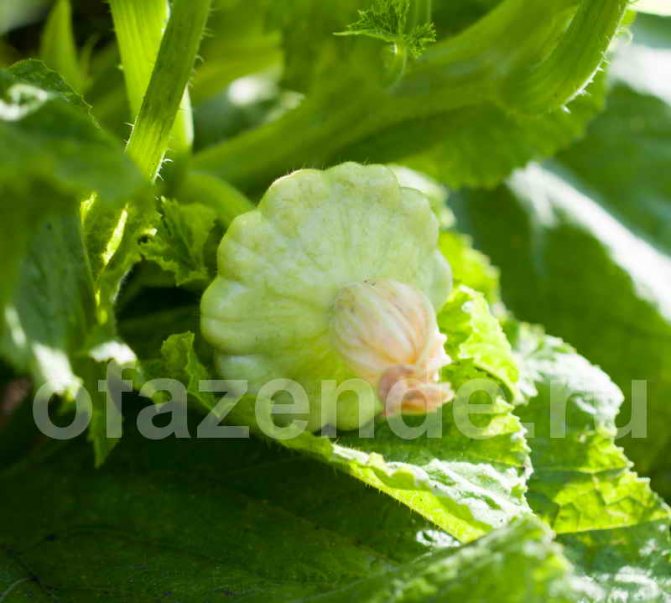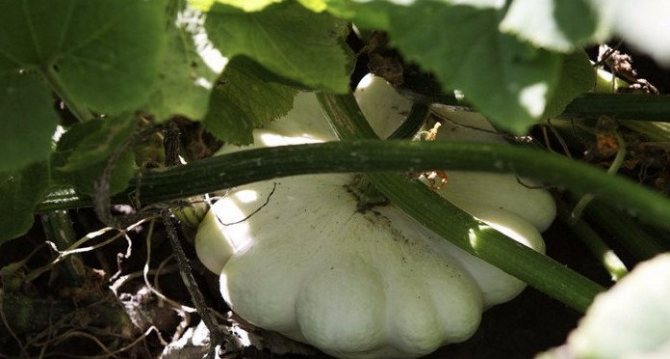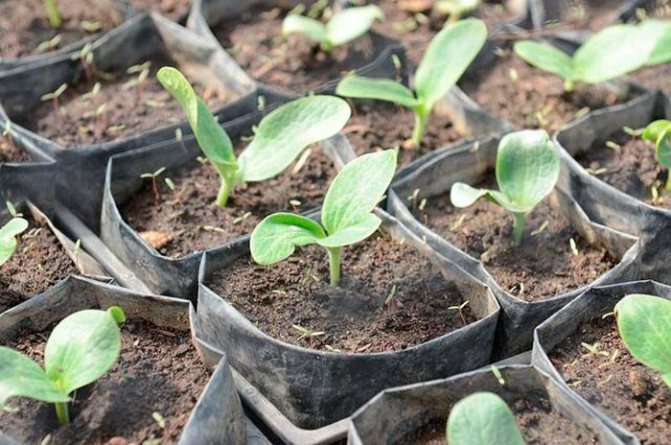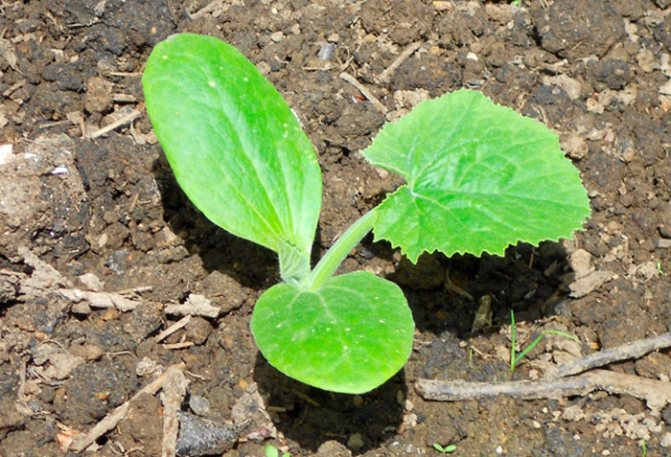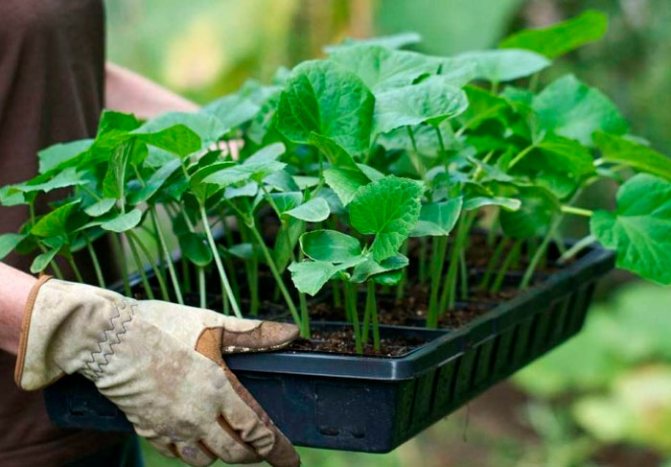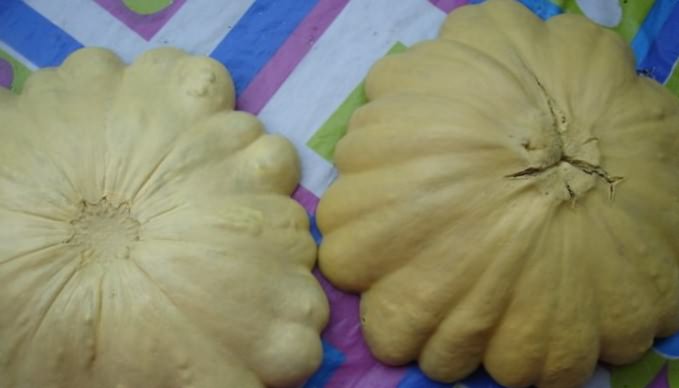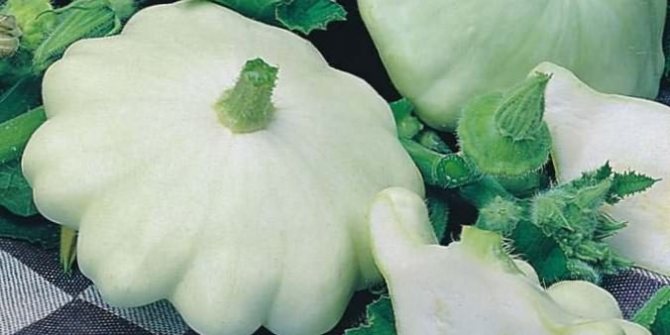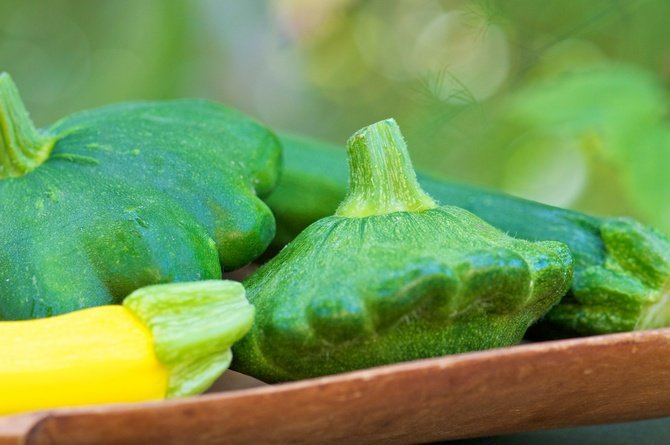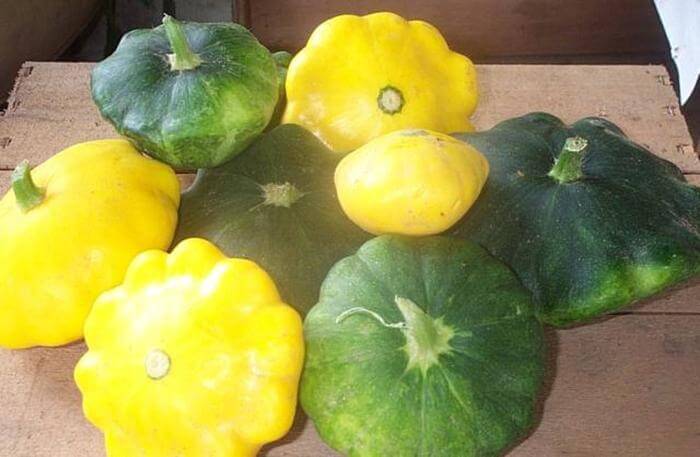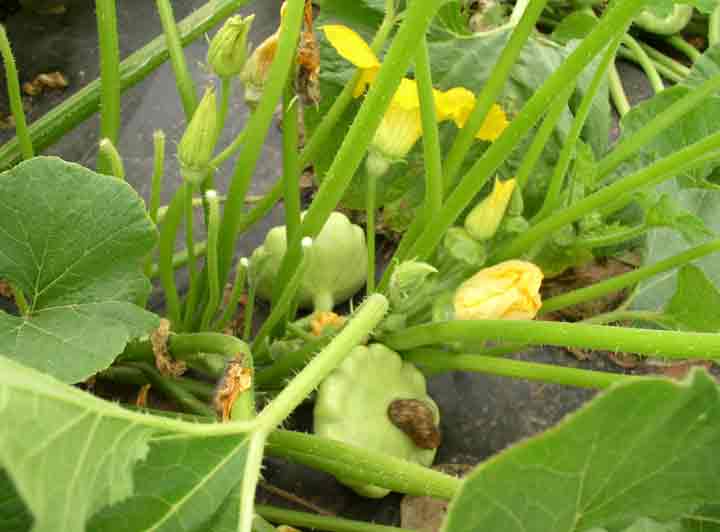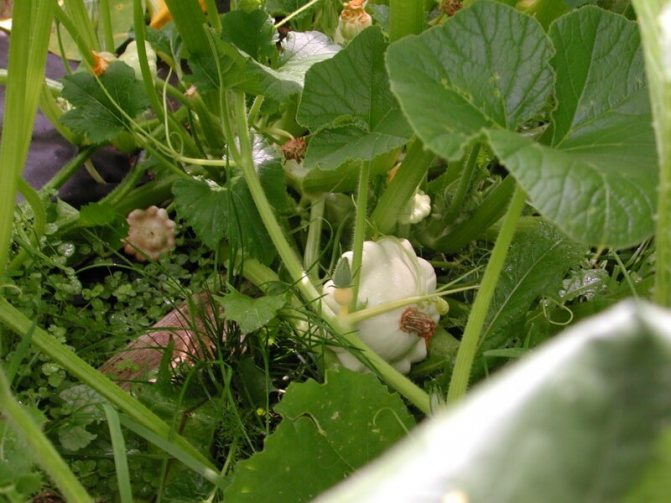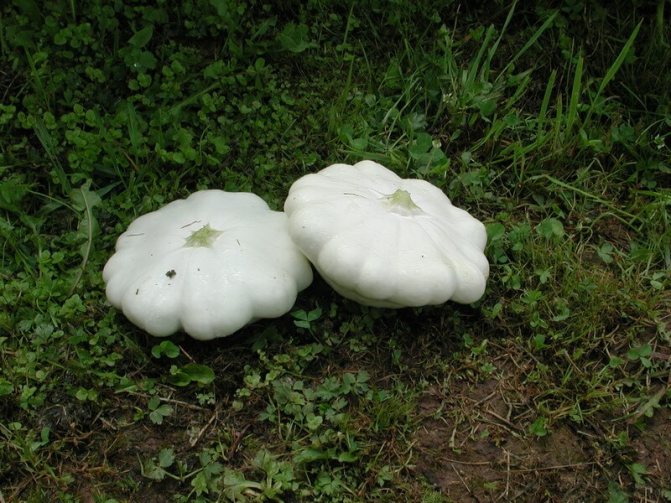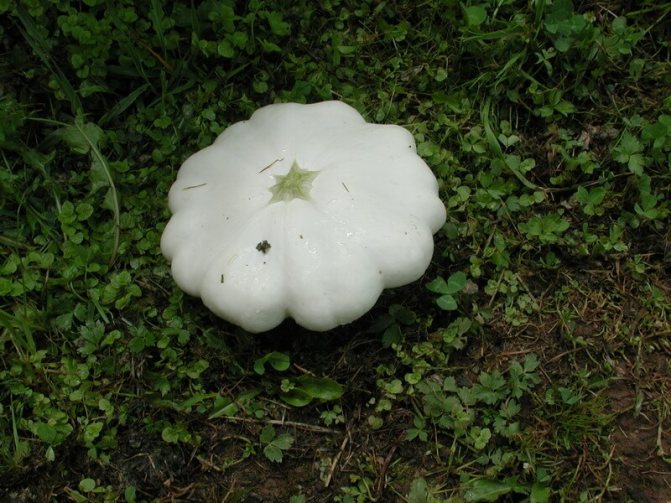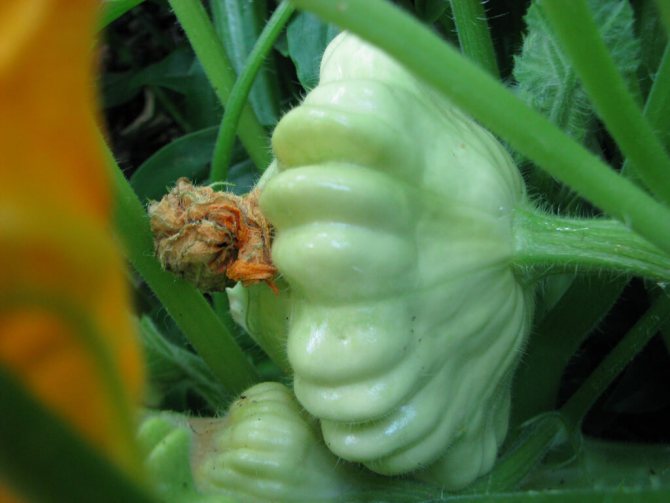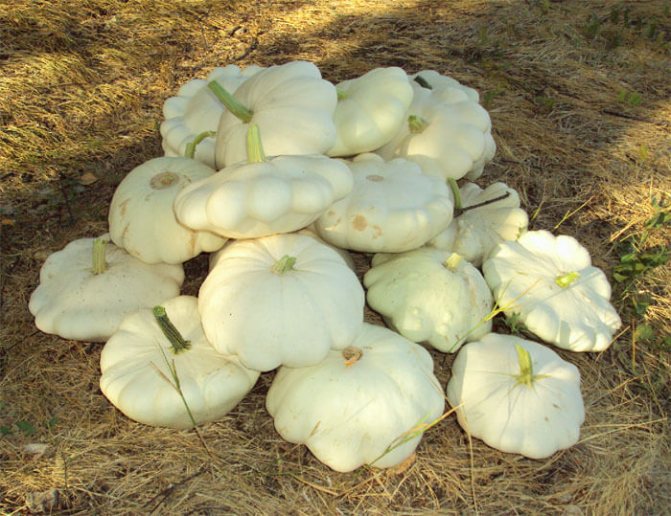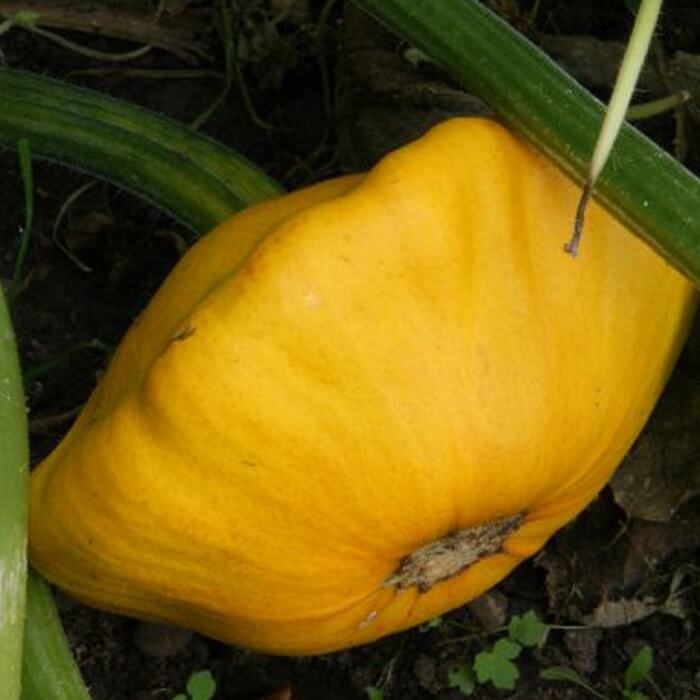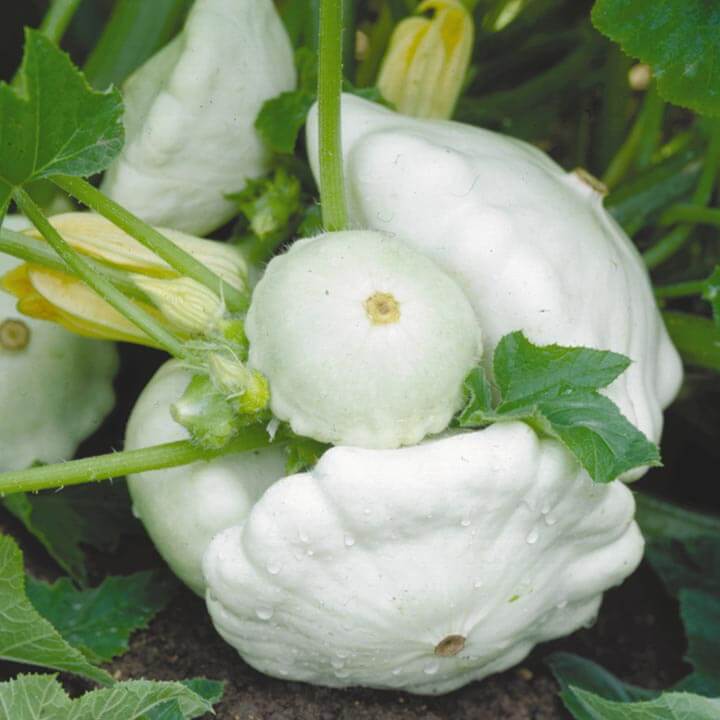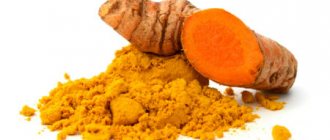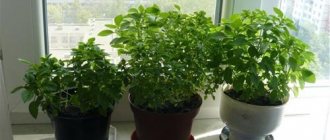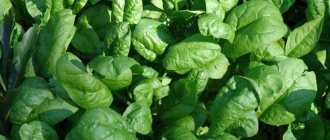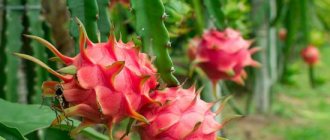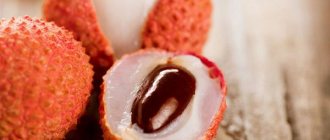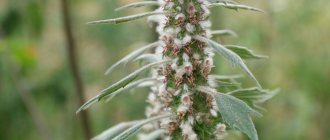Patisson is a plant of the Pumpkin family, which has a decorative rounded shape in the form of a plate, therefore, sometimes this vegetable is called a dish-shaped pumpkin. But still, the word "squash" comes from the French pâté (pie), because the fruits of the plant really resemble a beautifully designed dessert or pie. In terms of quality and taste, the fruits resemble zucchini, they are fried, boiled, salted and pickled.
The homeland of the squash is South America, from where it was brought by seafarers and discoverers of two continents in the 17th century. Currently, the vegetable is grown in almost all European countries, including Russia.
Based on the species that were once brought to the Old World, breeders managed to develop a lot of new varieties, with fruits of various colors, it can be white, green, yellow, with or without stripes and spots. Outwardly, the plant looks like bush zucchini, but there are also weaving forms among them.
A flowering bush of squash is easy to mistake for bush squash:
Squash varieties differ in terms of ripening, like all other vegetables, they can be early, medium or late. But at the same time, all varieties of squash are useful for humans, therefore they are used with pleasure in cooking and even in folk medicine, which takes into account the healing properties of seeds and vegetable juice. The most useful substance for a person in the composition of squash is lutein, which has a beneficial effect on human vision.
Early maturing varieties
Bingo bongo
Bingo Bongo ripens very early, 40 days after germination. The form of the plant is bushy, compact, does not take up much space on the site. It is distinguished from a number of congeners by violet-green fruits, which are shaped like discs with wavy edges. The flowering pulp is white, the taste is delicate, the structure is tender and juicy. Fruit weight - 500-600 grams. The fruits can be preserved and used for stewing and frying.
Bingo bongo
Gosh
The Gosha variety is early ripe, the first fruits can be harvested 38-42 days after germination. They are not very large, weighing 300-350 grams, their peel is dark green, and the flesh is white with a yellow tint. The variety is excellent for conservation, due to which the quality of the fruit is preserved for a long time. Gosha grows in the form of a bush, its flowers and leaves are just like those of zucchini. It bears fruit for more than a month, and during this time it gives about 5 kg of fruit.
Gosh
Disk
Variety Disk is distinguished by its white color and bell shape. Unripe fruits have a greenish tint, but gradually it disappears, and the fruits become pure white. They ripen quite quickly - 40-42 days after germination. The sizes of the fruits are small - 300-350 grams, small fruits that have not reached their final size can be plucked and rolled into jars as a whole. In this case, the yield of the bush will be low, but this deficiency will be compensated for by the taste and quality of canned squash, which will be eaten first.
Disk
Umbrella
The Umbrella variety is early maturing, the first crop is harvested 45-55 days after germination. Fruit weight is about 400 grams, yield per bush is 4-5 kg. The fruits are harvested after they reach 8-10 cm in diameter, with poorly developed seeds. In color, the fruits are white-green, or white.They are flat in shape with clearly visible denticles. The taste is wonderful, tender and juicy. Squash are suitable for preservation and preparation of daily meals, but fresh are not stored for a long time.
Umbrella
UFO Orange
Variety UFO Orange - large, weighing up to 500 grams, orange fruits, with mild wavy edges, will appear 45 days after germination. Their flesh is tender and juicy, white in color. The strong peel of mature squash can be used as a pot for baking vegetables in the oven and for stuffing. For stewing and preservation, fruits are used that have not reached technical maturity, with soft peel and pulp. The productivity of the bush is high, during fruiting it gives up to 15 kg of fruit.
UFO Orange
Polo F1
Variety Polo F1 is early maturing, growing in the form of a compact bush. Unripe fruits are light green, when mature they become pure white. Weight 300-400 grams. The variety attracts with a high and stable yield, which can be 10-15 kg per season, and disease resistance. The fruits are good both fresh and canned.
Polo F1
Sunny bunny
The Sunny Bunny variety is early, the fruits are harvested 40-42 days after germination. Their color is golden yellow, sunny, the flesh is white, with a slight yellow tint. The weight is small - about 200 grams, suitable for seaming, and for cooking stews and fried dishes. The Sun Bunny grows in a compact bush, during the period of active fruiting, it is literally strewn with golden squash plates, and can produce up to 15 kg of fruit per season. The variety is unpretentious, resistant to typical problems.
Sunny bunny
Cheburashka
The Cheburashka variety is super early, the first fruits ripen in 35-40 days. A variety of Russian selection, therefore, it tolerates cold and other unpleasant features of the continental climate well. The bush is climbing, but the whips are short - about 1 meter. The fruits weigh 250-400 grams and are plate-shaped with wavy edges. The color is white outside and inside. The pulp is tasty, juicy. Average yield - 4-5 kg per bush.
Cheburashka
Shatrez
The Shatrez variety is early ripening, with medium-sized fruits, the weight of which does not exceed 100-150 grams, and the diameter is not more than 5-6 cm. The peel of mature squash of this variety is dark green, with white or yellowish spots and stripes, the flesh is white, has a good taste. Mini-squash can be preserved without cutting, as a whole.
Shatrez
Sowing the seeds of squash, planting seedlings
Seedlings of squash are grown by the same methods and under the same conditions as squash.
If in the fall the soil has been sufficiently fertilized, then before sowing / planting the squash, you can add a teaspoon of ash to the hole and mix it with the ground. Dry soil must be moistened.
Seeds of squash or seedlings are sown / planted in an ordinary or square-nesting method according to a scheme of 50x50 cm or 50x70 cm.
The seeding depth of squash seeds depends on the type of soil. On light soils, seeds are buried up to 8 cm, on heavy soils - no more than 5-6 cm.
In each well, 2 seeds are sown, after germination, a weak sprout is removed.
Seedlings of squash by the method of transferring or moving out of the cups are planted according to the same scheme, one plant per hole. The seedling is buried in the soil to the first leaves. The soil around the plant is slightly compacted.
To create comfortable conditions for the plants, shelters are installed for the first time, especially with early sowing / planting.
Mid-season varieties
Mini crumb
The Mini crumb variety gives small fruits, they are put whole in a seaming jar. Their diameter is only 3-5 cm, weight is about 70 grams, taste like ordinary large squash. The variety is grown according to the usual technology, without making allowances for the small size of the fruit. Mini crumb grows in the form of a bush, and the fruits and leaves are small in the variety. Harvested 50 days after germination, fruiting lasts several weeks, during which 3-5 kg of squash are plucked from the bush. The mini Solnechny blast variety, which appeared on the Russian market relatively recently, is distinguished by similar qualities.
Mini crumb
Watermelon
It is not in vain that the Arbuzinka variety received such a name. In shape, this is an ordinary squash with wavy edges, but has a watermelon skin color and a melon berry flavor.The weight of one "watermelon" is 400-450 grams, fruiting lasts about two months, the yield is high - up to 15 kg per bush. The first fruits appear 50-55 days after germination, they are used for stewing, frying and canning.
Watermelon
Snow White
Variety Snow White - from the name it becomes clear that its fruits are snow-white, with white flesh. Snow White's bush is compact and neat, takes up very little space. The fruits weigh 250-300 grams and have a wonderful taste. The fruits are canned, stewed and fried. Fresh, in the refrigerator, they are stored for about two months.
Snow White
Malachite
The Malachite variety grows as a small shrub. Fruits are malachite green at first, when ripe they become lighter, have the shape of a disk without strongly pronounced denticles at the edges. The pulp is white, tender, with excellent taste. They are quite large - up to 550 grams, long-term fruiting, therefore, the productivity of the bush is high - up to 16-20 kg per season. The variety has good immunity to diseases and pests. The fruits are used for pickling, stewing and frying.
Malachite
Sun
The Solnyshko variety bears bright yellow fruits weighing up to 300 grams. They ripen in 45-50 days, but they are not kept until technical ripeness, but are plucked unripe. In this form, they are tastier for preservation and for stewing and frying. Small-sized squash become ideal "utensils" for baking and stuffing:
Sun
White UFO
The White UFO variety, like most white varieties, has bell-shaped fruits with well-defined wavy edges and a convex top. Their sizes are small - up to 8 cm in diameter, weighing about 100 grams. The peel may not be pure white, but light green, the flesh is white, with a wonderful taste. There are almost no seeds. If you pick them at the moment when their diameter is less than 8 cm, then there will be no seeds at all, and the taste will be even more pleasant. Ripening occurs in 50-55 days.
White UFO
Fried
- Time: 40 minutes.
- Servings Per Container: 5 Persons.
- Calorie content of the dish: 63 kcal.
- Purpose: for a snack.
- Cuisine: European.
- Difficulty: easy.
There are several options for making delicious fried squash. In a simple recipe, sliced fruits are fried in oil on both sides. To get a more nutritious and satisfying dish, flour batter is used. Cooking is just as easy, and it produces almost crunches with a crispy thin crust. Add cheese, garlic, and other spices to the batter if desired to add flavor and flavor to the zucchini.
Ingredients:
- squash - 3 pcs.;
- egg - 2 pcs.;
- flour - 4 tablespoons;
- vegetable oil - 50 ml;
- garlic - 3 cloves;
- parsley and dill greens - 50 g;
- salt, spices - to taste.
Cooking method:
- Wash the vegetables, peel and seeds if necessary, cut into rings 1-1.5 cm thick.
- Prepare everything for the batter: mix flour with spices, beat eggs and salt in a separate bowl.
- Fry the chopped fruits in a pan over high heat, first drenching the pieces in flour twice in turn and dipping them in an egg. The frying time is 3-4 minutes on each side.
- Sprinkle the finished zucchini with herbs and chopped garlic before serving to make them look exquisite, as for the photo.
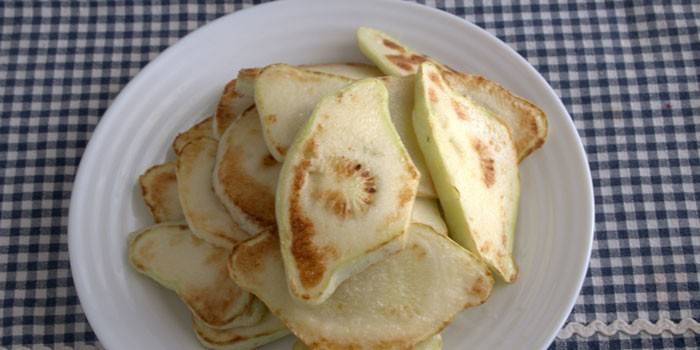
Late varieties
White 13
Variety White 13 - ripens in 60-70 days. It grows in the form of a small bush, covering an area of 70x70 cm. The variety is thermophilic, gives white or yellowish fruits, light tender pulp. The shape of the fruit is plate-shaped, wavy at the edges. The weight is quite large, up to 500 grams, in general, the yield is 6-7 kg per bush. The fruits are suitable for canning, stuffing, baking.
White 13
There are not so many late varieties of squash in Russia, and this is not surprising, the plant is thermophilic, and the summer is short here, in August the nights are already cold, which significantly reduces the crop yield.The first fruits have time to form and ripen, however, due to the cold weather, the fruiting period is reduced. Therefore, the main requirement for the late variety is its cold resistance and the ability to form fruits at night temperatures in the range of 10-15 degrees.
Somehow it has already become a tradition that domestic gardeners, who are happy to grow unpretentious zucchini and pumpkins, deprive the attention of squash. Meanwhile, this vegetable is excellent in taste, very healthy, and not so difficult to grow. The varieties and types of squash presented below with photos and descriptions will give an idea of this culture, and recommendations for care will allow you to get a good harvest without problems.
Preparing and fertilizing the soil before planting
Patissons are propagated by seeds, sowing them on seedlings or directly into open ground. Experienced gardeners advise combining these two methods to get an early and even harvest.
To ensure high germination of seeds, they must be properly prepared for sowing. Despite the high yield, some measures should be taken to increase germination (Figure 2):
- Wrap the seeds in cheesecloth and lower them in a boric acid solution for a day, then rinse and dry;
- Harden the seeds: rinse them with water, wrap them in cheesecloth and keep them at different temperatures for three days (6 hours on the bottom shelf of the refrigerator, and the rest of the time at room temperature).
The choice of the site for sowing also plays an important role in obtaining a good harvest. A sunny location, moderately sheltered from the wind, is best for this crop. They begin to prepare the garden in the fall: the earth is fertilized with organic matter and dug up. Acidic soils are additionally fed with lime.


Figure 2. Preparing seeds for sowing
In the spring, the land is leveled, weeds are removed and mineral fertilizers are applied. The fertility of the soil is also important, therefore, depending on the type of soil, it is necessary to apply special fertilizers. For example, peat soils are supplemented with manure humus, superphosphate and wood ash. Clay ones are fertilized with peat and humus, and sandy ones - with turf, peat and sawdust.
Plates, discs and umbrellas
Squash is part of a large family of pumpkin seeds, is grown everywhere today, although the American continent is considered the homeland of the vegetable. The plant is bushy or semi-bushy (climbing varieties are also found), with a powerful stem and large green leaves.
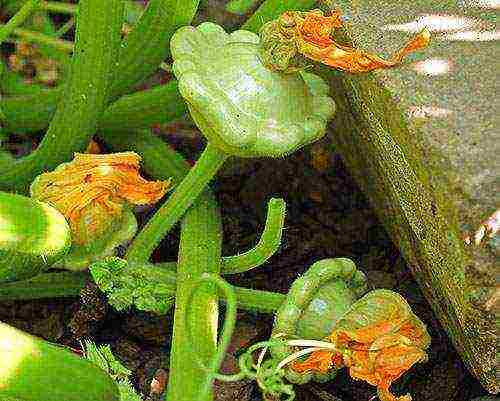

Large flowers have a bright yellow color, they are monoecious and unisexual. The fruits are round, depending on the variety, they can have a plate or bell-shaped shape, smooth edges or with scallops. The color range of pumpkin fruits is diverse, and if earlier everyone knew mostly white squash, nowadays you can grow emerald, orange, yellow, purple fruits in the garden. Available in variegated, striped and spotted varieties.
IMPORTANT!
By its nutritional and taste qualities, squash "overtakes" zucchini.
The pulp of the fruit is distinguished by its high density and good taste. Squash is used for various types of marinades, any preservation is good with them. Also, a wide variety of dishes are prepared from squash, including mashed potatoes, caviar, stews, pancakes. This vegetable is great for preparing stuffed dishes, as well as candied fruits.
ON A NOTE!
Many people note that canned small squash tastes like porcini mushrooms.


Patissons differ not only in color, shape, but also in terms of ripening. For most regions of Russia, varieties and hybrids with early and medium ripening periods are best suited, allowing for faster harvesting. Also on sale are not only varieties, but also hybrids, which are characterized by unpretentiousness, simple care and fairly high yields.It is advisable to plant plants with different periods of fruit ripening on the garden bed in order to get squash throughout the season.
ON A NOTE!
The multi-colored fruits of some varieties of vegetables will become a very original decoration of garden beds.
Gardeners prefer to grow universal varieties, the young of which are suitable for conservation and pickling, and the large ones are processed.
How to cook squash
You don't need to have a high level of culinary skill to cook squash quickly and tasty. The product goes well with other vegetables, accelerates the assimilation of protein foods (meat products, mushrooms, cheeses). It is important to remember that it is not recommended to use it raw, but prolonged heat treatment also reduces the taste and usefulness of the "sunny zucchini". For all recipes, fruits are more suitable:
- small size (no more than 7 cm in diameter);
- free from spots or other defects on the skin;
- dense;
- with a dried stalk.
Squash dishes
You can cook from squash as a mono dish (by frying or stewing a vegetable with spices and garlic), and salads, stews, soups. Delicious pancakes with onions, vegetable snacks (they can be pickled for the winter), fruits stuffed with a mixture of rice and other vegetables, mushrooms, chicken fillets and cheese are delicious. Patissons are used to make pie filling, custard. In America and European countries (for example, in Greece), the flowers of the plant are pickled, fried in batter.
Descriptions of varieties and hybrids of squash
Traditional white
In the review, we decided to make the color gamut of the fruits of this interesting garden crop a criterion for classification. And the review will open a description of white-fruited squash - practically the ancestors of all others.
Snow White
For beginners who are just mastering the agricultural technology of this vegetable, the productive variety Snow White is an excellent choice. This variety is distinguished by early ripening (up to 47 days), a powerful bush. The fruits look like small white discs, there is a slight segmentation, along the edges there are teeth. Weight - no more than 350 grams.
The squash is thin, the flesh is snow-white, crispy and very dense. Baby fruits are great for preservation, pickles, large squash are used in cooking.
White 13
One of the most famous varieties of white-fruited squash. On a powerful sprawling bush, a large number of squash discs with a whitish-green peel are formed. They appear 55-67 days after the appearance of the first shoots, therefore the plant belongs to mid-season varieties. With good care, up to 4 kg of tasty fruits can be harvested from one square meter.
IMPORTANT!
It is recommended to collect squash when their diameter does not exceed 8 cm. It is during this period that they are especially tasty, later the pulp becomes fibrous.


Fruits can weigh up to 500 grams, small squash can be well preserved, larger ones can be used for cooking.
UFO (White)
Fruits of the UFO White variety have excellent taste. Ripening time - up to two months, while the plant is cold-resistant.
The UFO patisson variety is appreciated for its unpretentiousness, productivity. Patissons are large, traditional for culture in the form of a plate, with a skin of white-light green color. The pulp has a dense structure. It is recommended to remove the UFO squash when it has a diameter of no more than 6-8 cm. The weight of overgrown squash can reach 800-1000 grams.
Cheburashka
Another variety that Russian gardeners love is Cheburashka. This is an early ripe squash, which forms fruits already 40 days after the appearance of the first shoots. Its white "saucers" reach a weight of up to 400 grams, have a smooth surface, juicy and very tender flesh.
Patisson Cheburashka is distinguished by a strong, powerful bush, good fruit set, resistance to temperature changes.This variety belongs to those few squash that do not reduce productivity even with small drops in air temperature.
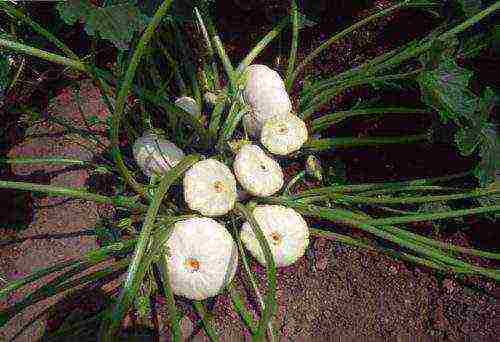

IMPORTANT!
Early squash Cheburashka is recommended for cultivation in regions of risky farming.
The fruits are suitable for all types of processing and conservation.
Umbrella
The review of white-fruited patissons will be incomplete, if you do not mention the productive and unpretentious Umbrella variety. It is included in the group of early-maturing species; you will need to wait only 45 days before harvesting.
Fruits are large, up to 1 kg, with snow-white juicy pulp. The peculiarity of this variety: the sweet taste of the pulp, since the composition contains a high sugar content. Also, the Umbrella variety is distinguished by long-term fruiting, therefore, with proper and good care, from July to the end of August, ripe umbrella fruits can be harvested.


A remedy from which plants grow by leaps and bounds! Just water your plants with it ...
Sunny vegetables
In this group, descriptions of squash are offered, which have a yellow or orange color. On the beds, bushes with such fruits look very festive and elegant, and they are not inferior in taste, and some even surpass their "pale-faced" counterparts.
Toddler
The squash from the agro collection under the original name Karapuz became famous for its excellent yield. This novelty has proven itself well among gardeners in different regions.
The bush of the Little Boy is compact in size, the fruits are bright yellow, plate-shaped. The average weight is no more than 500 grams, but for preservation and pickles, it is recommended to use small squash. Toddler fruits can be stored for a long time, they are also suitable for transportation.
UFO (Orange)
Among the early yellow squash, attention should be paid to the UFO Orange variety. Firstly, it ripens early (it takes only 45 days), and secondly, this squash is one of the best varieties for canning. It looks very impressive on the garden bed.
The flattened fruits are disc-shaped, the edge with small wavy scallops. The skin is dense, orange in color, but the juicy pulp is snow-white. The yield of the variety is excellent, and if you follow all the rules of care, then up to 25 fruits weighing 300-400 grams can be removed from one plant.
IMPORTANT!
UFO variety Orange is resistant to low temperatures.
This squash is suitable for all types of preservation, as well as in cooking.
Fouette
The Fuete variety has also proven itself quite well, the weight of the fruits of which reaches an average of 300 grams.
The plant is a bush type, fruit in the form of plates, with a scalloped edge. Patissons have a beautiful yellow color, but their flesh is snow-white, very juicy. The fruits are used for preservation, they are also good for baking.
Sun
A little longer, about 60-70 days, you will have to wait for the harvest of squash from the Sunny variety. But on the other hand, these fruits can be stored for a long time after harvesting, while the taste will not be lost.
The Sun has a compact bush, and the fruits reach a mass of 300-350 grams. The color of the squash is yellow, the shape is in the form of a disk with small waves along the edge. The pulp is creamy and firm. All fruits on the bush are even, up to 12-15 squash can be removed from one plant.
This variety is one of the best for preparing original stuffed dishes.
Sunny Bunny F1
If there is a variety Solnyshko, then how not to be a hybrid Sunny Bunny. Refers to early ripening squash, it takes about 45 days until the fruits ripen.
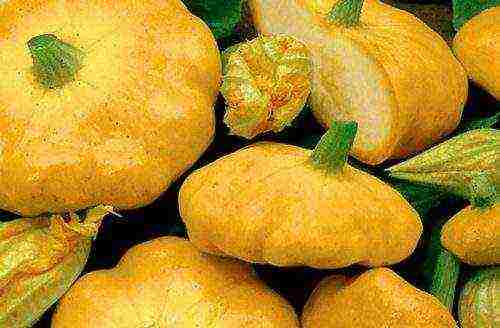

This hybrid has a powerful spreading bush, on which up to 18-20 fruits can grow at the same time. The yield is excellent, while the plant is highly resistant to various diseases.
The fruits of the Sun Bunny are medium-sized, weighing up to 150-200 grams, yellow disc-shaped. There is a slight ribbing along the edge.The pulp is creamy, very firm. The hybrid is intended for canning with whole fruits.
Solar Blast F1
Another squash is a tiny Solar Explosion. It is a mid-early hybrid of squash, has a good yield.
Fruits of a bright yellow hue, in the form of tiny discs, weighing up to 100 grams. The flesh is of a beautiful creamy color, there are very few seeds. This hybrid, like the Sun Bunny, is recommended for conservation.
Penny
Among the novelties of miniature squash, one cannot fail to mention the Kopeyka gherkin. This is a super-early squash, the ripening time of the fruits of which is only 37 days. The plant is a bush type, compact, forms flowers of a predominantly female type.
The variety has a good yield, while being successfully grown in all regions of the country. The fruits are small, orange discs, weighing only 30 grams. The yield is friendly, while the squash does not crack, does not outgrow within two weeks. Used for whole pickles and marinades.
Sunny Delight F1
Lovers of romance are invited to pay attention to the very fruitful hybrid Sunny Delight, which in Dutch means Sunny Charm. The manufacturer is the well-known company Seminis.
This squash has an early ripening period (up to 40 days), is resistant to diseases and temperature changes. The plant is a bush type, weak branching, forms squash weighing up to 75-80 grams. The color of the fruit is yellow, the shape is in the form of a disk with a small carved border. Resistant to greening, the pulp is juicy, creamy, very tasty.
It is used for the production of baby food, as well as fresh.
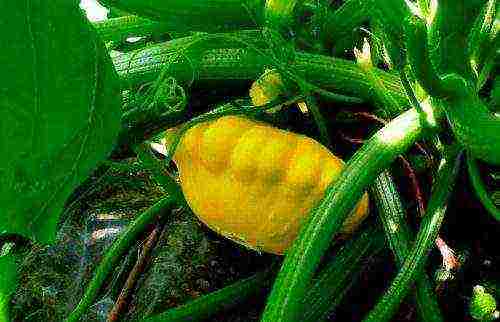

Features of planting squash in the open field
In the garden, a place for squash is prepared in advance, in the autumn. For planting, you should choose a sunny, wind-protected area. A southern, southwestern location will do.
Soil preparation
For squash, neutral soil acidity is important. Deoxidation is achieved by adding wood ash in the amount of one bucket (10-12 liters) per 1 m2 or liming the soil with dolomite flour (the application rates are indicated on the package, they depend on the acidity of the soil). Loose chernozem or non-acidic loams are suitable.


When calculating the rate of application of dolomite flour per garden bed, the acidity level and soil composition are taken into account
Soil preparation consists in deep digging of the selected area. At the same time, earth clods do not break. Along the way, mineral and organic fertilizers are applied (superphosphate, wood ash, manure, peat, humus). Spring work begins by re-digging with crushing of overwintered clods, loosening the top layer of the soil.
Planting dates with seeds and seedlings
Sowing squash with seeds in the ground can be done when the soil warms up to 10 ° C and above. At temperatures above +14 ° C and above, germination will go faster. For the Moscow region, this is usually the end of spring and the beginning of summer. Seeds are sown directly to the prepared place. In each hole 2-3 seeds are placed at a depth of 6 cm in light soil (for example, sandy loam) or 4 cm in dense and heavy soil (for example, in clay). Top crops are sprinkled with a layer of peat to maintain soil moisture. After the emergence of seedlings, the plantings are thinned out, leaving one (less often two) strong sprout. The rest are either destroyed or transplanted to free areas.
It is important to keep track of spring frosts, which are detrimental to heat-loving crops. If there is a threat of frost, the bed with squash must be covered with a spunbond with a density of at least 60 g / m2.
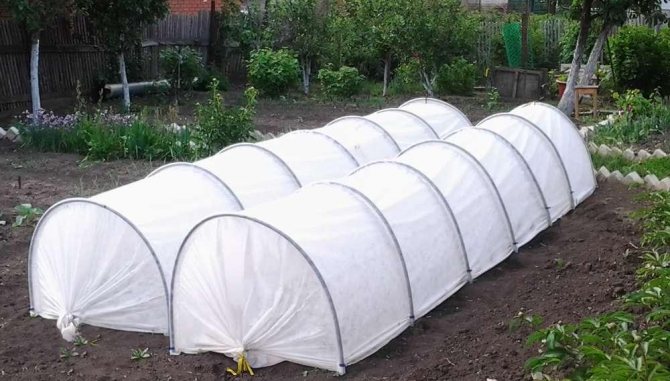

With the threat of frost, the bed with squash is closed with spunbond
To obtain an earlier harvest, seedlings of squash are grown at home or in a greenhouse. Using this method allows you to get fruits 20-25 days earlier.Seeds are sown on seedlings about a month and a half before transplanting mature seedlings under the open sky (mid or late April).
In open ground, seedlings are transplanted at the age of about six weeks. By the time of planting, there should be at least three true leaves on young plants. Relocation to a permanent place occurs at the end of May and the beginning of June with the obligatory preliminary hardening of young growth on a glassed-in balcony or cold veranda. After a week, the sprouts are planted in the garden at a permanent place. The garden bed must provide shelter from cold nights and return frosts. To do this, use film opening greenhouses, spunbond. Warm beds are well suited for squash. Heating on them is carried out from below, due to manure or humus, placed under the upper earthen layer. Such a bed heats the plant all season, while feeding it with organic feeding.
Landing scheme
Plants are placed on the site in a tape way or nesting (in squares). The placement option is selected taking into account the possible size of an adult bush and the shape / size of the garden bed. For a narrow bed, it is convenient to form one or two rows. A wide allotment provides an opportunity to choose any of the proposed planting schemes.
Table: schemes for placing patissons in the garden
| Placement method | Compact bush | Sprawling bush |
| Two-line tape (in a row) x (between lines) x (pass) | 50x70x90 | 50x70x90 |
| Square-nested | 50x50 | 70x70 |
Photo gallery: from the first shoots to flowering


In order to avoid picking and injuring young shoots, it is better to plant each squash seed in a separate container.
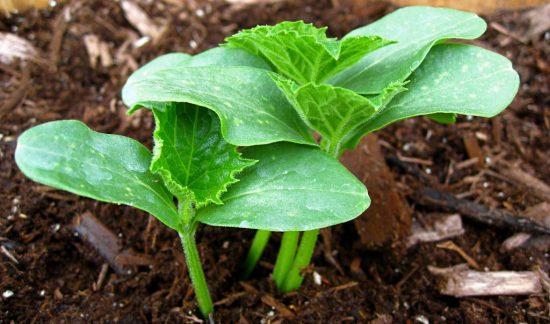

When planting squash seeds directly on the garden bed, 2-3 seeds are planted in each hole


With the onset of warm weather and after the end of return frosts, the seedlings of squash are planted in the garden
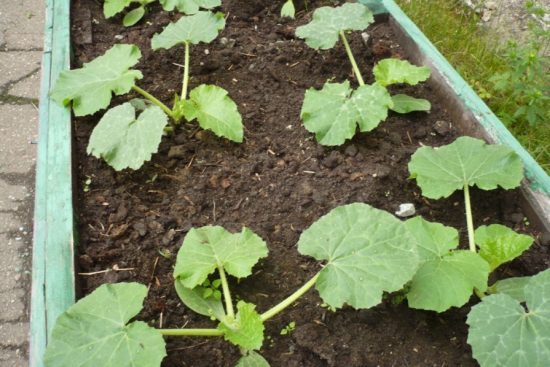

The distance between the patissons should be at least 50 cm
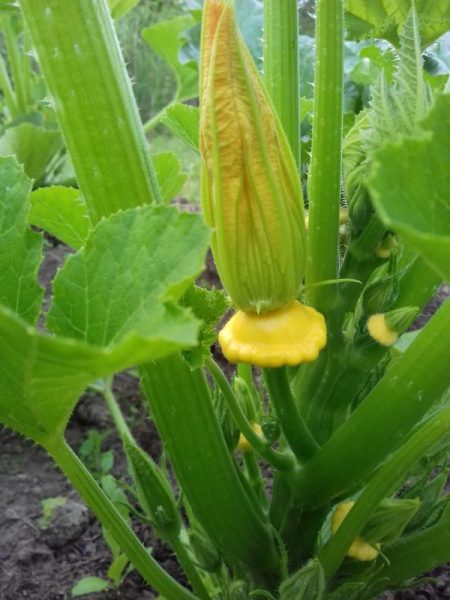

Female squash flowers immediately form ovaries
The best neighbors and predecessors for squash in the garden
Correctly selected neighbors in the garden will provide the squash with a protective barrier from pests and increase the yield:
- marigolds planted nearby, nasturtium will save from the invasion of aphids;
- garlic growing in the same garden will help prevent powdery mildew;
- potatoes with corn affect the yield of squash and increase the duration of fruiting. Although there is no unambiguous opinion about the neighborhood next to potatoes;
- radishes and squash mutually complement each other when planted together;
- on the site of early varieties (after harvesting), they practice planting siderates, which allows the use of the land without downtime.
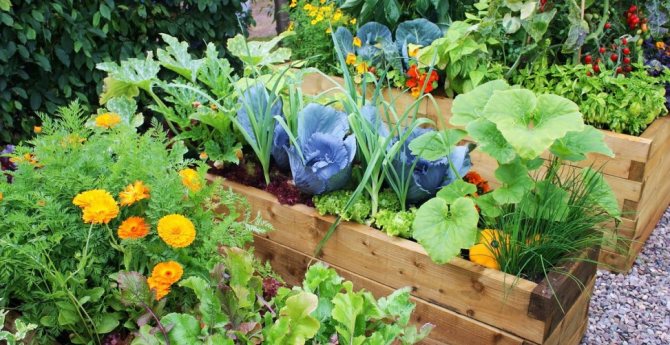

Marigolds planted next to the squash will protect the plants from the invasion of aphids
For squash, as well as for other garden plants, favorable and undesirable predecessors are characteristic. Good soils after nightshades (potatoes, tomatoes), greens, legumes, onions, radishes, cabbage (Beijing, cauliflower), siderates (oats, mustard, phacelia).
It is worthwhile to be afraid of using the places from which the harvest of related crops (zucchini, cucumbers, pumpkins) was harvested in the previous season. In addition, it is not recommended to place them side by side during the growing season. This will provoke cross-pollination, which will further lead to a loss of varietal qualities in the obtained seeds. However, if the collection of seed from your own plants is not important, then related crops will serve as additional protection from weather manifestations (wind).
Emeralds in the beds
The next group is squash, the fruits of which are green in color, while the shades can be very different.
Gosh
An interesting variety of squash, the fruits of which are at first painted in a pale green color, and as they ripen, they change to dark green and almost black.
The plant is bushy, vigorous. The first squash ripens about 50-52 days after germination.Fruits in the form of a disc, there is a slight segmentation on the surface. Average weight - no more than 350 grams. The skin is firm, the flesh is white, juicy and crispy. Gosha is a versatile variety, therefore it is suitable for preservation (small fruits) and for various culinary dishes.
Chartreuse F1
One of the most disease resistant is the fruitful Chartreuse hybrid. It is an early hybrid, forms fruits of green color weighing up to 400 grams. Patissons have the appearance of a disc; as they ripen, yellow stripes may appear on the surface. Young fruits with salad pulp are suitable for canning, fresh consumption, and more mature squash are used for processing.


Malachite
Another green-fruited miracle is a variety of squash Malachite. Patisson begins to yield 45 days after the appearance of the first shoots, it is highly resistant to diseases, cold snaps. Squash Malachite - like small plates, have a border around the edges. Their average weight is 400-500 grams, the skin is of a rich green hue.
The pulp is juicy and very tender, the taste is excellent. Feature of the variety: resistance to drought, so even with irregular watering, the crop will still please.
Watermelon F1
This original squash will delight gardeners not only with good yield, but also with its exotic appearance. Its fruits are small discs, have a variegated color, giving them a resemblance to watermelons.
The hybrid is not afraid of many diseases, it ties squash even under unfavorable conditions. Variegated squash reaches a mass of 300 grams, inside them there is a juicy pulp with an unusual taste for a vegetable and the aroma of fresh forest berries.
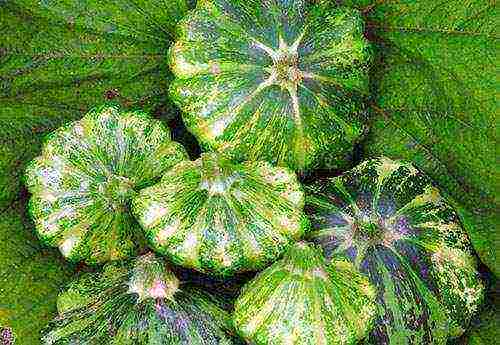

Useful properties of squash
In terms of chemical composition and useful properties, squash is superior to squash. Young fruits contain a large amount of carbohydrates, sugars (in the form of glucose), pectin substances, fats, and mineral salts. Squashes differ in the content of a large list of micro- and macroelements: molybdenum, titanium, aluminum, lithium, cobalt, phosphorus, potassium, calcium. The composition of useful compounds includes more than 10 types of vitamins, including those from the group "B", "E", "A", "PP" and others.
The rich chemical composition determines the usefulness of squash for a healthy diet and its effect on human health:
• squash - an excellent dietary product; • prevents the development of cardiovascular diseases, atherosclerosis, hypertension; • lutein contained in fruits neutralizes the effects of free radicals, protecting the body from oncology; • helps to strengthen vision; • squash juice removes excess salts; • normalizes bowel function, etc.
Add some color to the beds
It is impossible to dispense with the review without describing the patissons with an unusual color. This variety deserves attention not only because of its exotic appearance, but also because of its excellent taste and very high yield.
Bingo bongo
On a beautiful small bush of the Bingo-Bongo variety, unusual fruits ripen in July - lilac squash. They have the shape of discs with weak segmentation, reaching a mass of 450-650 grams. They look very colorful on the garden bed, attracting the views of others.
Squash Bingo-Bongo have juicy and tasty pulp, which is not quite typical for these vegetables tenderness. The peculiarity of this squash: unusual color of the fruit, a raised rosette.
Lilac squash are used for preservation, in assorted tomatoes and cucumbers they look festive and very original.
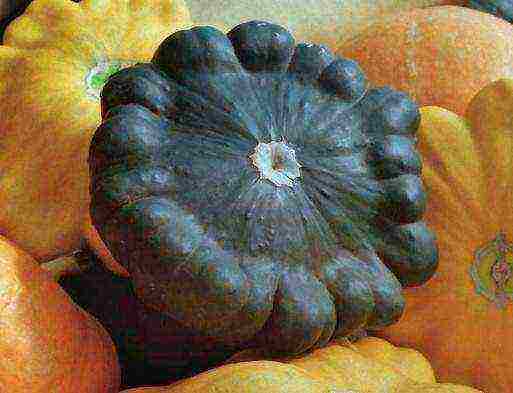

As you can see, gardeners who want to plant squash on the site have a huge selection. The main thing is not to be lazy and to provide the culture with good care, and then the harvest of delicious multi-colored plates and discs will surely delight you!
Small patissons are vegetables that are great both for stewing and frying, and for preparing for the winter. They keep as well as pumpkin.Previously, the varieties of squash had only a white skin and pulp, regular shape with small waves along the edge. Early varieties with orange peel and varied shapes are available today.
Squash varieties are:
- early, which are harvested 40-50 days after the first shoots;
- mid-ripening, yielding in 50-60 days;
- late squash with a harvest of 60-70 days.
Beautiful fruits of different colors are tasty and healthy. Doctors recommend eating this vegetable for those who suffer from hypertension, vascular disease, kidney disease.
Stuffed
- Time: 90 minutes.
- Servings Per Container: 6 Persons.
- Calorie content: 290 kcal.
- Purpose: garnish.
- Cuisine: Greek.
- Difficulty: medium.
Choose this recipe if you are thinking of how to prepare an unusual and not too complicated squash dish. For the filling, choose a protein product (minced meat or chicken), add vegetable ingredients, mushrooms and sauce to it. In the vegetarian version of the recipe, meat is replaced with rice. It is better to use very small fruits for stuffing, of the same size, with intact skin.
- How to freeze bell peppers for the winter
- Rating of the most effective fat burners
- Crafts from vegetables for kindergarten
Ingredients:
- squash - 6 pcs.;
- minced meat - 400 g;
- onion - 1 large head;
- garlic - 2-3 cloves;
- champignons - 150 g;
- hard cheese - 60 g;
- sour cream - 150 ml;
- butter - 30 g;
- black pepper, salt, spices - to taste.
Cooking method:
- Prepare the filling: chop the onion (chop into small cubes) and garlic (grate), fry the mushrooms a little (5-7 minutes). Mix ingredients with minced meat, pour over sour cream, add spices and salt.
- Wash the zucchini fruits, carefully cut off the top, clean out the seeds and pulp, leaving the walls 1-1.5 cm thick.
- Fill the vegetables with the filling, put a slice of butter each, cover with the tops.
- Place in a cauldron or heavy-bottomed saucepan. Fill with water, simmer under the lid for 30-40 minutes.
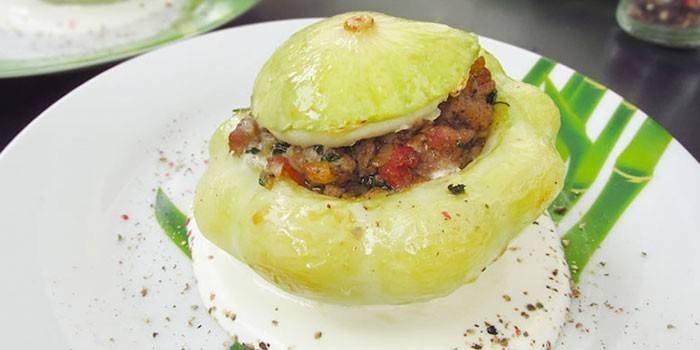

Popular varieties of small squash
Yielding varieties of small squash:
- Variety White 13 - the best for open ground. Pumpkins of this species have a weak division into segments. They taste like zucchini, the flesh is not so sweet, and the skin is shiny. Fruits weigh from 300 g to 500 g. For a full season, almost 4 kg of delicious and healthy squash can be harvested from one bush.
- Another hybrid belonging to the early maturing - Polo F1... Bushes grow compact, young fruits are distinguished by light green skin. After they are ripe, the color turns white. Fruits weigh from 300 to 400 g. The flesh of the squash is very tasty and is suitable both for canning and for preparing various dietary dishes. The variety gives a consistently high yield, it is resistant to many diseases. It can be safely acquired by beginners who do not yet have experience in growing vegetables.
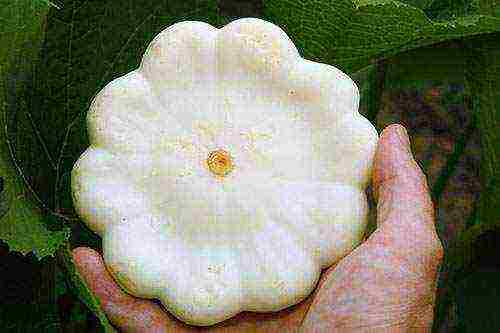

Also read: Characteristics and features of growing Chinese cucumbers


- Hybrid Sunny Bunny F1 refers to early maturing. It has a consistently high yield, up to 20 pumpkins can ripen at the same time on one copy. This variety can also be attributed to mini, the weight of ripe fruits is only 150-200 g. The pulp is dense, tasty, light orange or creamy. The hybrid is resistant to powdery mildew and other diseases.
- Squash hybrid Watermelon F1 looks like a watermelon. The fruit is disc-shaped, which becomes rounder as it ripens. Refers to mid-ripening varieties with ripe fruits weighing up to 450 g.
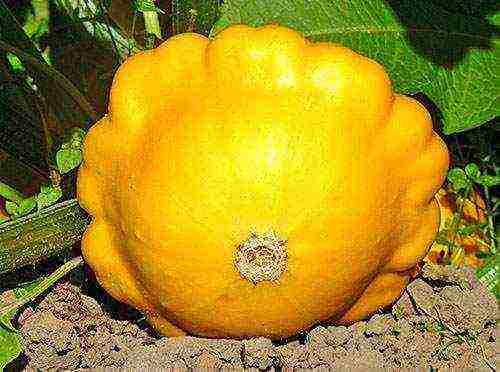

- Delicacy hybrid Chartreuse F1 has a high yield and early ripening. Ripe fruits are green and dark. Young squash with tasty soft greenish flesh, in mature ones it is much lighter. If the ovaries are up to 3 cm, they are great for use in salads, larger ones are suitable for preparing almost any vegetable dish.
- Gosh - squash with large and strong bushes. The weight of dark green fruits reaches 300 g. When preserved, the dense consistency characteristic of these fruits is preserved. The variety has a consistently high yield and resistance to rot and diseases.
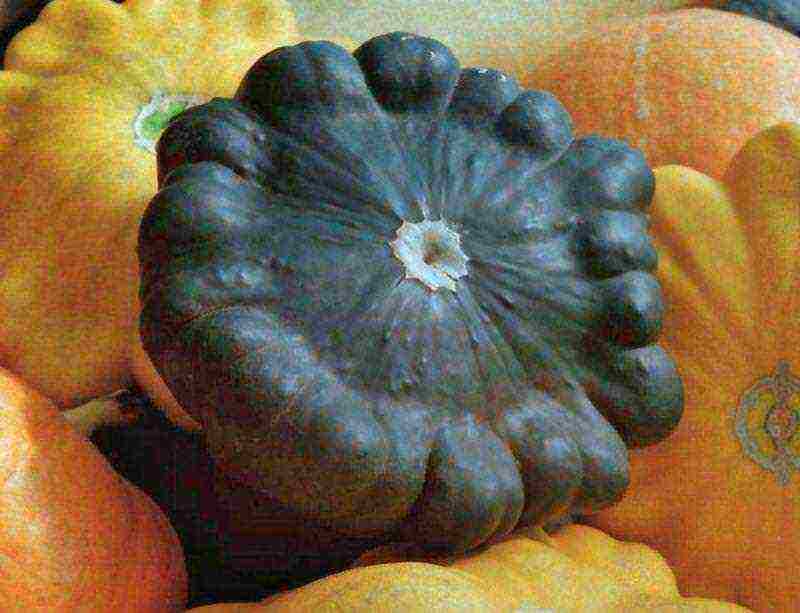

How to choose
Those who plan to "acquire" this useful and truly beautiful vegetable, in the middle of winter, begin to select seeds.
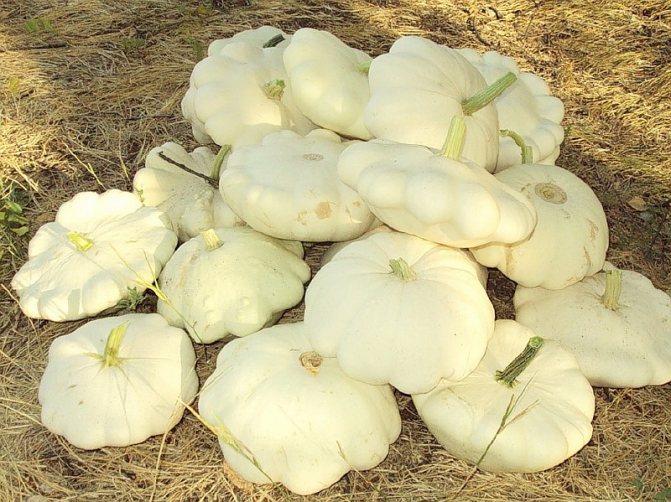

There are many different varieties. The main division occurs in terms of ripeness from the moment of ascent to the finished product.
So, there are the following types:
- Ultra-early and early varieties. These species are ready for consumption within 37-50 days after the first shoots appear in the ground.
- Species of average maturity. The harvest of such varieties can be harvested after 55-60 days.
- Late-ripening varieties. These species go through the tying process 60-70 days after planting.
If you choose a variety of species for planting, then all summer they will decorate with bright colors and unusual shapes of the beds. And also to please with a constant presence at the table.
Descriptions of the different varieties are presented, in more detail, in the following sections.
The specifics of sowing small patissons
When sowing, it is best to use seeds that are no more than 3 years old. If the seeds are fresh, they need to be warmed up for several days. In order for them to rise faster, they are soaked in a solution of boric acid for several days, washed with water and dried. When the first leaf appears, 1 plant is left in the hole. If the bushes are too dense, you need to cut off several sheets for good ventilation and access to flowers for bees.


Small fruits up to 7 cm in diameter are harvested for preservation and desserts. For cooking dishes and salads - up to 12 cm.
All the while growing and harvesting, the bushes need to be fed and watered.
The rules for caring for squash are similar to those that apply to zucchini, only the ground around the bushes needs to be loosened more often. Top dressing for plants is applied only 3 times. The first time after the first shoots appeared. The second and third time - after the appearance of the first ovaries. In order to prevent burns on the leaves, they need to be watered with clean water after feeding.
Squash salad
- Time: 40 minutes.
- Servings Per Container: 4 Persons.
- Calorie content: 146 kcal.
- Purpose: for a snack.
- Cuisine: European.
- Difficulty: medium.
Warm salad and squash and vegetables are prepared easily, but not quickly, since vegetables are added alternately during stewing at a short time interval. It is better to chop the ingredients on a Korean carrot grater, or manually cut into thin long strips. This salad goes well with potato side dishes and various casseroles. The greens are added last, a few minutes before the end of cooking.
Ingredients:
- squash - 3-4 pcs.;
- carrots - 2 pcs.;
- onion - 1 pc;
- bell pepper - 2 pcs.;
- garlic - 3 cloves;
- spices, herbs, vegetable oil for frying - to taste.
Cooking method:
- Wash and peel the courgettes, chop or cut into strips. Simmer over low heat for 5-7 minutes.
- Peel, chop the carrots, add to the squash, fry for another 5-7 minutes.
- Chop onion, pepper, add to carrots, fry all together for 7-10 minutes.
- Chop the garlic, herbs, add together with spices to vegetables 2 minutes until cooked.
How to preserve squash (video)
You need to harvest the squash regularly, about 2-3 times a week, after they reach the desired diameter of up to 12 cm. Cut the squash together with the stalk and immediately process it. Fruits are suitable for storage after full ripening. Many owners make a common mistake - they do not remove some of the leaves from too dense bushes. Foliage thickening leads to a decrease in yield, as there is no proper ventilation.
Patisson is an excellent vegetable for preparing dietary dishes, it is suitable for everyday and festive menus.
Pickled
- Time: 60 minutes.
- Servings Per Container: 8 Persons.
- Calorie content: 176 kcal.
- Purpose: appetizer.
- Cuisine: Russian.
- Difficulty: easy.
Canned squash turns out to be juicier if you marinate the vegetables without cutting, whole. The main secret of how to make a delicious winter snack from these zucchini lies in the spicy unusual marinade, which gives a rich aroma. It is better to pasteurize jars and lids before rolling. This can be done in any convenient way - in boiling water, in the oven, or over the spout of a boiling kettle.
Ingredients:
- small squash - 1 kg;
- cherry tomatoes - 150 g;
- water - 1 l:
- salt - 1 tablespoon;
- sugar - 1 tablespoon;
- dried star anise - 2 flowers;
- cumin - 0.5 tsp;
- garlic - 4 cloves;
- bay leaf - 3 pcs.;
- vinegar (70%) - 2 tablespoons
Cooking method:
- Sterilize the jar and lid. Wash the vegetables thoroughly, fold inside the jar together with the garlic, tightly. but without squeezing the fruits, so that it turns out aesthetically pleasing, as in the photo.
- Boil water, pour into a jar, stand for 15-20 minutes, drain. Repeat.
- For the third time before boiling, add everything for the brine (except acetic acid) to the water. Pour boiling marinade into a jar, add vinegar, roll up a lid.
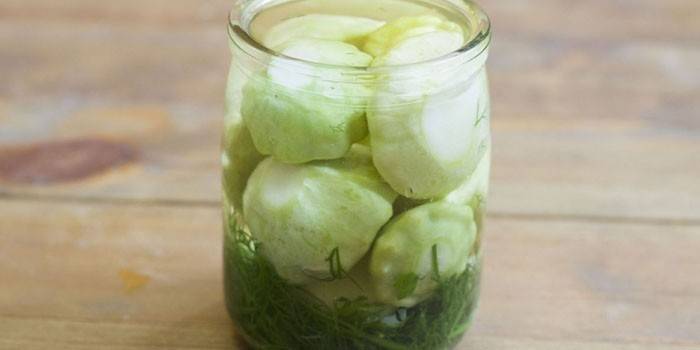

Reviews and comments
Did you find a mistake in the text? Please select it and press Ctrl + Enter. Thank you!
Rating:
(
estimates, average:
out of 5)
Squash is an annual thermophilic vegetable crop, successfully grown in central Russia. It has both culinary and decorative value. Their pumpkin fruits look spectacular both on the garden bed and on the table, and are even used in interior decoration. All types of heat treatment are allowed - salting, stewing, pickling. From them you can bake pancakes and use them as baking pots.
For different purposes, different varieties are used, which differ in shape, color, size, ripening time and growing conditions. Each of them has its pluses and minuses, so it is best to choose them based on a specific purpose.
This crop is often mistakenly called dish pumpkin or simply mini pumpkin. In fact, it is an independent species, but it really belongs to the pumpkin family.
Care basics
Squash care includes the following procedures:
- loosening and mulching, weeding,
- thinning,
- pollination,
- protection of fruits from excessive moisture,
- watering,
- top dressing.
Loosening, weeding, mulching
From the moment of planting and until the plant is removed from the garden, it will be necessary to regularly weed the bushes, preventing the weeds from drowning out both young growth and adults. Loosening the soil around the bush is rarely used and superficially, trying not to damage the roots. Exposure of roots is eliminated by adding soil, mulching (the latter helps to reduce the amount of loosening and weeding). Sawdust, peat, humus are used as mulch.
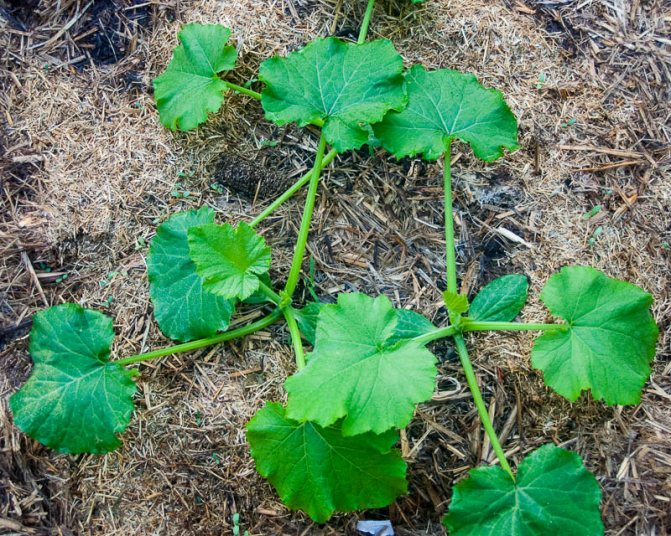

It is convenient to use cut and dried grass from the lawn as mulch for squash
Thinning
The abundance of large, strong leaves affects the qualitative and quantitative composition of the crop. Thickened bushes are thinned out by cutting off one or two old leaves at a time. The procedure is carried out in the morning, with an interval of 2 to 4 days.
Pollination
Cloudy, rainy weather during the growing season also adds complexity. In such weather, pollinating insects do not fly over blossoming flowers, pollination does not occur. You have to "work as a bee" yourself, manually pollinating each opened female flower with a male one.
Video: manual pollination of plants using pumpkin as an example
Protection of fruits from moisture
Fruits, depending on the purpose of use, are harvested either small, so-called technical ripeness, or waiting for biological ripeness (that is, when the fruit has reached the color and size required for the variety).If heavy fruits lie on the ground, it is advisable to make supports under them so that they do not rot. On a mulched bed (especially if a black spunbond or black film acts as mulch), the fruits also remain dry and clean.
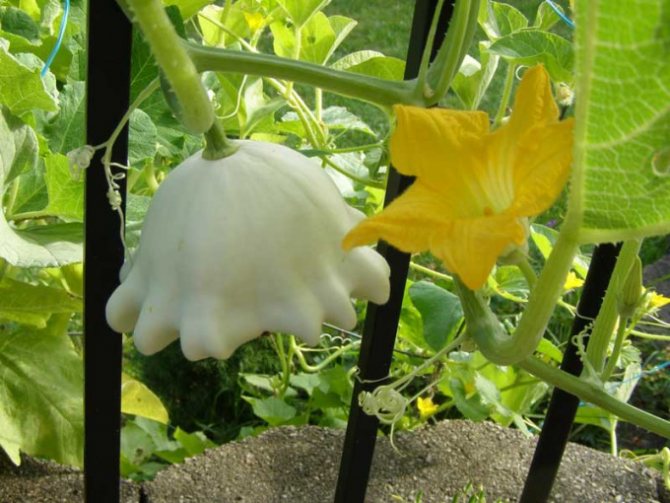

The fruits of the squash lying on the ground are lifted with the help of special props to prevent decay
Watering
Regular watering is carried out throughout the entire life cycle of the plant. The phases of development of squash affect the volume and time interval of moisture. From the emergence of sprouts and until the onset of the flowering pore, they are watered once every 5-6 days, waiting for the soil around the bush to begin to dry out. The volume of water used is 6–8 liters per m2. From flowers to full ripening, moisture consumption increases by a couple of liters. The frequency of watering leaves once every 3-4 days.
Water is used standing, heated to 23 ° C. The temperature of the liquid is important as cold watering is dangerous for the plant. It weakens the defenses of squash and leads to disease. Water the squash gently. Do not allow liquid to get directly on the plant. For convenience, grooves are made around each bush. To retain moisture in the soil, each watering is completed by laying a layer of mulch.
Nature makes its own amendments to the planned schedules and modes. A dry hot season will add the amount of irrigation carried out; in cold, damp weather, it is worth taking care of the prevention of excess moisture and hypothermia of the grown crop, i.e., reduce the number of waterings and cover the plants with spunbond at night.
Top dressing before planting and during growth
Preparatory tillage (application of mineral and organic fertilizers) before planting provides the squash with useful substances for the entire growing season. In other cases, the use of fertilizers is carried out at least twice a season. For the first time, young vegetation is fed, which has developed four adult leaves. One of the working solutions is used:
- Agricola-5 (25 g of the preparation per 10 l of water) - the volume obtained is sufficient for watering from 10 to 20 m2 of area;
- a mixture of 20-25 g of potassium salt and 50 g of superphosphate (for 10-12 liters of water);
- Harvest, Kemira-universal or Growth II (25–30 g per 10 l of water), 500 ml for each plant.
The second time feeding is carried out during the period of bud emergence and ovary formation. It is better to use organic fertilizers - any of the proposed options of your own choice or on the advice of experienced gardeners:
- one part mullein to 10 parts water, with the addition of potassium sulfate (20 g) and superphosphate (15 g);
- one part poultry manure to 15 parts water.
For the third time, if required, fertilizers are applied after two weeks from the previous feeding. Use solutions of complex mineral preparations, as in the first application, or an ash solution with urea (a glass of wood ash, a tablespoon of urea in a bucket of water). Consumption is from one and a half to two liters per plant. When applying top dressing, overfeeding of the culture is unacceptable. An excess of organic matter - namely nitrogen - leads to abundant growth of lashes and leaves, which can negate all efforts to obtain a crop.
Video: caring for squash: how to achieve a large harvest
The best varieties of white squash
White 13
A popular unpretentious variety with relatively small fruits. It has the best taste in the "weight category" 80-100g. It can grow up to 0.5 kg, but the rind becomes quite tough and the flesh is watery. Differs in high cold resistance, ripens in 65-70 growing days. It takes 6-7 weeks from flowering to harvest. The taste is lightly salted, neutral, the density is average. It can be recommended as the best variety for open ground in mid-latitude conditions. The advantages are good keeping quality, ease of maintenance and high yield.


Umbrella
Semi-bushy early maturing variety with a vegetative period of 40-50 days.It has a dense white flesh and a smooth surface, sometimes with a slight tuberosity. The color is whitish, sometimes with a slight green tint. Bell-like shape with pronounced teeth. The fruits are large enough, with an average weight of 300-400g. Individual specimens can grow over a kilogram in weight. The firm flesh has a slight sweetish flavor. Designed for conservation, extinguishing. The disadvantages are low keeping quality and poor endurance during transportation.
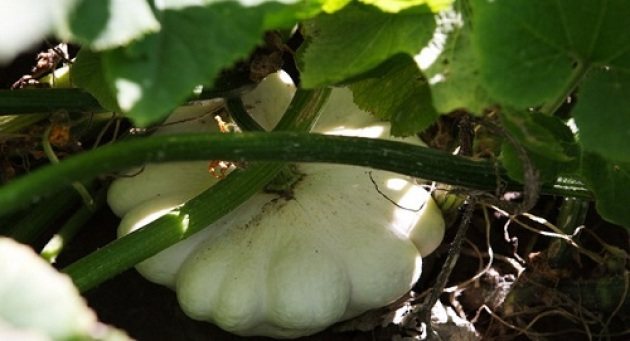

Disk
Refers to early ripening, "pumpkins" weighing up to 400 g can be removed after 40-50 days. They have a disc-like shape, a pronounced segmented surface and a smooth, hard skin. The serration is poorly expressed. Medium-dense pulp, neutral taste, crunchy.
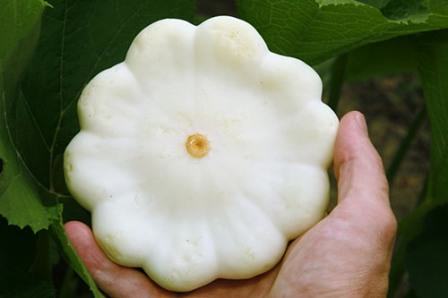

Suitable for daily cooking and preservation. Keeps well fresh.
This variety is more susceptible to powdery mildew than others!
Cheburashka
Differs in high cold resistance and increased branching. Can be grown in northern regions. The first harvest can be removed after 36-40 days, after which, with proper care, it bears fruit for a long time. It has a dish-shaped shape with a slightly wavy edge. Fruit diameter - 9-10 cm. Delicate pulp has excellent taste and high density.
Ufo white
Mid-season (vegetation period 45-55 days), bush. Squash are large, 400-600g (some specimens can reach 1 kg), dish-shaped. But for preservation, they require earlier collection, while the skin is soft and tender. For storage, on the contrary, overripe fruits with a hard skin are suitable. They lie well and are resistant to cold weather.
Landing site
Obtaining increased yields depends on the competent choice of soil and the site where the squash will grow. Crops of melons and gourds need to fertilize the soil with potassium, as well as magnesium. This is a prerequisite for the efficient cultivation of these plants.
Acidic soil will not benefit the plants, therefore it must be processed by liming, adding dolomite flour to it.
Large leaves of squash need sunlight, which should also influence the choice of location.


It is recommended to add organic fertilizers to the soil. It is preferable to carry out this procedure in the autumn. Manure and humus will not be superfluous, but only have a positive effect on the condition of the soil for further cultivation. After fertilization, the soil is dug up and not cultivated until the onset of the spring season. During this time, physical and chemical processes will take place, contributing to the enrichment of the soil.
After the establishment of warm weather, cultivation of the soil from weeds and loosening is allowed.
The best yellow-orange varieties of squash
These varieties are bred on the basis of white varieties, have a yellow-orange color due to the high content of carotene. In addition to excellent taste, they are valuable as an additional source of vitamin A and lutein.
Patissons are often recommended for dietary and medical menus. Especially useful for vascular disorders, anemia, gastrointestinal diseases.
Sun
A high-yielding variety, excellent for canning, with small, uniform, rich orange fruits - no more than 200-300 g. They grow on a compact bush, from which you can collect an average of 15 bright spectacular squash. The pulp is firm, creamy. One of the best varieties in this group, suitable for pickling, stuffing, baking, stewing. Ripening period - 55-65 days. Resistant to powdery mildew.
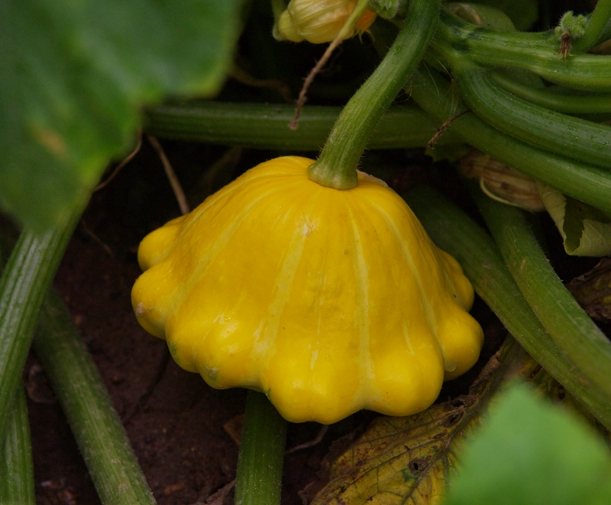

Sunny bunny
Also one of the best small-fruited early maturing varieties. Good for whole canning. Bears fruit amicably and abundantly due to the fact that it forms a predominantly female color. It is unpretentious in leaving. The creamy dense pulp has a rich flavor range.
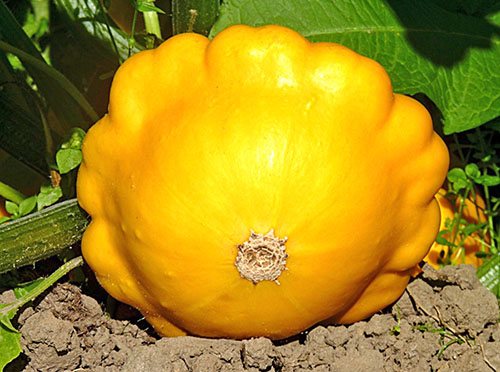

Sunny Delight
An early ripe bush hybrid producing miniature squash, ideal for pickling.
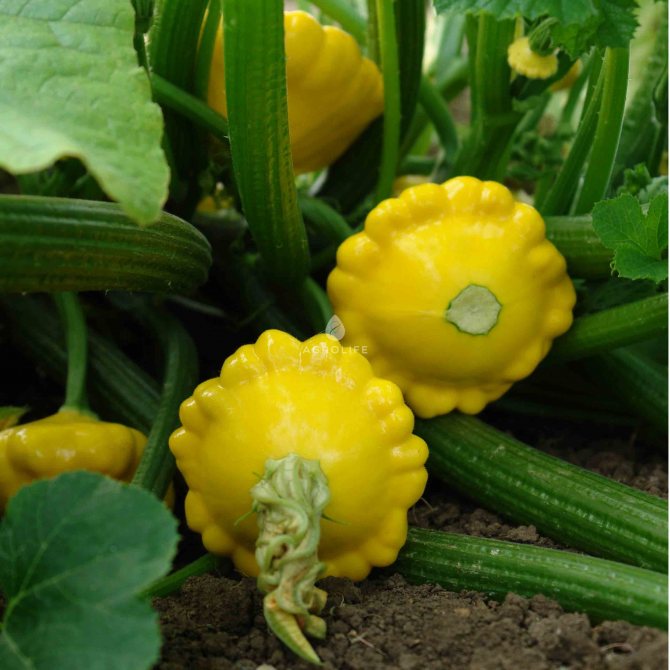

They grow in mass only 60-80g.With the same stated ripening period, they usually yield a crop a week earlier than other small-fruited varieties. It tolerates dry summers well.
For a richer harvest, plant squash after potatoes, radishes, peas, tomatoes, onions, or carrots.
Diseases and pests
Despite the resistance to diseases and pests, under certain conditions (high humidity, too dense planting), squash is sometimes affected by such diseases (Figure 5):
- Anthracnose - provokes the formation of brown spots on the leaves. Gradually, the stems and leaves are covered with a pink fungal bloom, which spreads to the fruit. Affected vegetables are removed and burned to prevent further development of the disease. Anthracnose develops in high humidity.
- Ascochitosis causes the formation of black spots on leaves and stems. Without treatment with special chemicals, the plant may die.
- White rot characterized by the formation of light spots on the leaves and stems, which gradually turn into ulcers with mucus. After that, the disease spreads to the fetus.
- Powdery mildew - the affected plant is covered with a white bloom. Gradually, the culture stops bearing and dries up.
- Black mold - at the initial stage, brown spots appear on the leaves and stems, which turn into holes. The disease also spreads to the fetus. They shrivel and dry out.


Figure 5. Diseases of squash: 1 - anthrocnosis, 2 - ascochitis, 3 - white rot, 4 - powdery mildew, 5 - black mold
Among the main pests allocate (Figure 6):
- Garden and winter scoop - a butterfly laying eggs on leaves. Caterpillars that emerge from eggs destroy leaves and roots, leading to the death of the plant.
- Melon aphid sucks juices from shoots, flowers and ovaries. As a result, the plant does not have enough juice for development, and it dies.
- Naked slugs pose a great danger to young shoots, as they can completely destroy their leaves. During fruiting, they also damage mature fruits.
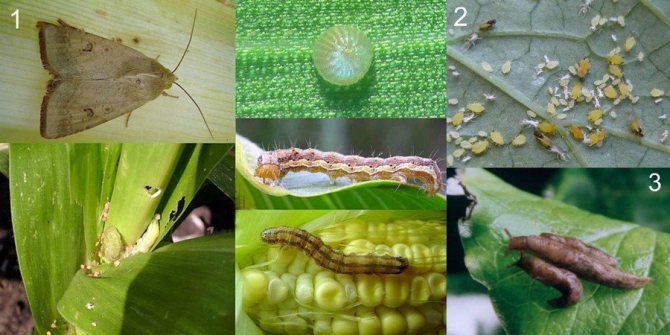

Figure 6. Common pests: 1 - garden scoop (at different periods of development), 2 - melon aphid, 3 - naked slugs
In order to prevent infection with diseases, you need to strictly follow the rules of crop rotation, do not place vegetables in the garden too densely and treat seeds and plants with Bordeaux liquid or fungicides for prevention.
Slugs are harvested by hand, spreading pieces of other vegetables in the beds. A mild soap solution is used to combat aphids, and special chemicals are used to eliminate scoops.
The best green-fruited varieties of squash
Chartorez
A very beautiful small-fruited hybrid with an early yield - the growing season lasts just over a month. Fruits are glossy, deep dark green in color. White or yellow streaks sometimes appear as it ripens. The young, pale green flesh gradually becomes pure white. It has exceptional taste and is suitable for preservation.
Gosh
A hybrid of the professional series. Gives tall, strongly growing bushes and disc-shaped pumpkins of 300-400 g. At first they have a dark green color, which gradually turns into black as it matures. The crispy flesh is very dense, tasty, milky-creamy. It is appreciated for a long yield period and high decorative and taste qualities.
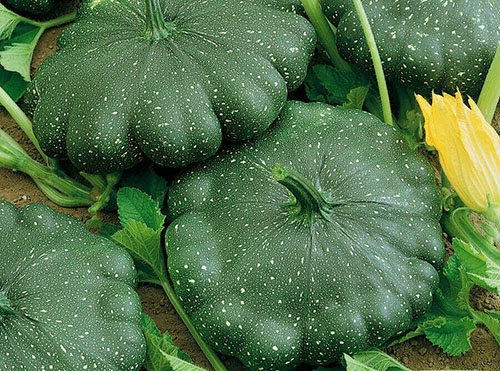

Seed preparation
Patissons differ in that they are able to grow from seeds thrown into the ground. However, in order to secure the harvest, it is recommended to carry out their preliminary preparation.
Step-by-step seed preparation consists of the following algorithm of actions:
- The first stage is heating the seeds in the oven at a temperature of 50 degrees. This procedure is about


exists in order for more female flowers to appear, which will form ovaries in the future. There is an alternative option - this is warming up on the battery.For this, the seeds are laid out on a cardboard surface and placed on top of the battery. - Seeds must be processed in a solution of potassium permanganate.
- It will take about two days to germinate the seed.
- For hardening, put the seeds in the lower compartment of the refrigerator and leave them for 6 hours.
- Patissons begin to sow in late April or early May. The holes should be three centimeters deep. It is allowed to plant two seeds per one prepared hole.
Another effective way for seed preparation work is to soak them in special solutions. Experienced gardeners use aloe juice and water. In specialized stores, you can buy substances developed for pre-soaking seeds. These include: "Energen" and "Bud". After pre-soaking, the seeds need to "rest" on a damp cloth. In this case, the temperature regime should be set at 23 degrees.
Purple squash
Bingo bingo
Compact bush variety with edible decorative fruits. Under the dark purple rind, a tender and juicy white flesh ripens. May have dark green varieties. Productivity and keeping quality are average, early ripening, about 40 days. It grows up to 500-600 g, but for conservation it is advisable to pluck at a younger age.
This is not the whole list of the best varieties of this spectacular vegetable, in addition, the market is constantly updated with new products. Many of them differ little in care and cultivation, and often in appearance, so it is not difficult to choose a variety according to certain specified characteristics. All the varieties described are suitable for growing in mid-latitude climates, have high taste characteristics, take root quickly, and give a good return. Therefore, it remains only to choose the best for your taste and color.
Soil preparation for squash
For squash, neutral soils with a pH of 6-7 units are needed. If in previous years the soil was fertilized only with mineral fats for a long time, it is quite possible that the soil is acidified. The soil can be deacidified from autumn by soldering or sowing green manure before winter. Wood ash application rate 0.2-0.3 kg / sq. m area. If peat ash is used for deoxidation, the rate is increased by 1.5-2.0 times. For winter sowing of siderates, vetch-oat mixture, mustard with legumes, vetch, etc. are used.
Be careful! When deoxidizing the soil in autumn with ash, do not mix it with fertilizer. Entering chemical reactions with fertilizers, ash will transfer some of them into forms inaccessible to plants. In such cases, fertilizers are applied in the spring directly under the planting of squash.
It is more practical to add humus or mature compost for digging under the squash in the fall (they will lower the slight acidity and serve as fertilizer). It is better to transfer the application of mineral fertilizers to the spring and supplement it with spring-summer dressings.
Site selection
One and the same place for squash in the culture rotation can be used 4-5 years after the last planting in this area of this plant. If the gardener seeks to get a good harvest, it is advisable to plant siderates (predecessors) useful for squash - various types of cabbage, nightshades, including potatoes, onions, carrots, parsley.
It is not recommended to sow seeds or plant seedlings of this culture in the soil on which related vegetables (zucchini, cucumbers) were previously grown, since cross-pollination is possible. For good germination, the optimal air temperature parameters must be observed: in the daytime up to +25 ° С, about +18 ° С at night.
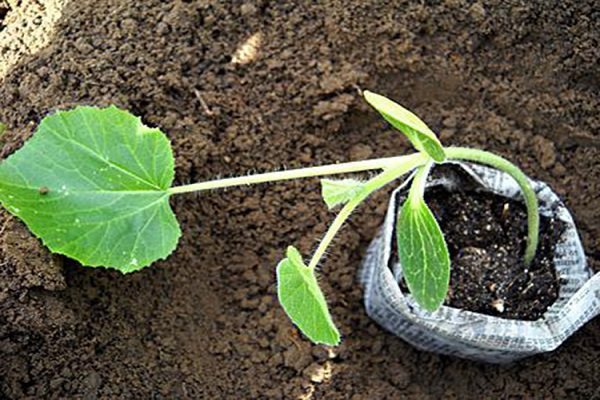

Watering rules
Until the seedlings are firmly rooted, they will need abundant and timely watering. It needs intensive watering during the period of active fruit formation.
Exceptionally warm and settled water is suitable for irrigation. You need to carry out the procedure every five days. You will need 8 liters of water per square meter. As soon as the flowering period begins, the amount should be brought to 10 liters.
You need to pour water under the root or into a small ditch that can be dug around the plant. It is important to keep water away from leaves, flowers and ovaries. Heavy watering will expose the roots, so they need to be protected by adding mulch during the growing season.
Did you know? Due to the fact that the squash is distinguished by an intricate shape, they are not cut into cubes, like zucchini. The middle is removed from them and stuffed. The filling for such a dish can be vegetable, meat, or sweet.
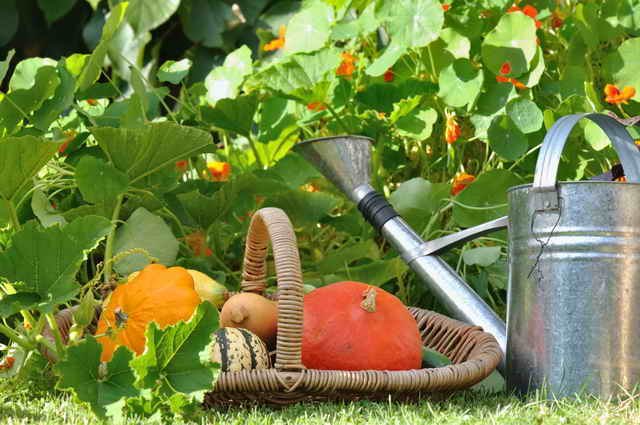

Watering rules. Illustration for this article is used under a standard license.
Photo gallery
Application in landscape design
The culture is sometimes used in ornamental gardening. In the summer, she is able to decorate the garden. It can be planted in an original way - in large barrels or bags. Such structures are placed in the center or along the perimeter of the site, near resting places. Large flowers and fruits of the original shape distinguish the plant favorably from other plantings.
Another use case is to create "tasty" or "edible" flower beds. With their help, the vegetable garden turns into an original garden, which bears the harvest at the end of the season. The peak of decorative culture falls on the periods of flowering and fruiting.
The original fruits are of interest. In Europe, they are used to decorate premises, and in the USA they are used instead of pumpkins on Halloween.
Squash at home
Patisson is a bushy plant and, moreover, quite compact. It can be planted in a container or large pot and grown at home.
Its root system is shallow, so the capacity should not be too deep. Diameter - about 60–70 cm. Drainage holes are required. A layer of expanded clay, pebbles, brick chips 3-5 cm thick is poured onto the bottom.
As for the soil, any universal seedling substrate is suitable if it is mixed with humus or fertile sod soil in equal proportions. For the prevention of fungal diseases, a tablespoon of crushed chalk or powdered activated carbon is added to each liter of the finished mixture.
The container is placed near a window facing southeast or southwest. In order to avoid burns of the leaves, it is advisable to protect the squash from direct sunlight. In the summer, the pot is taken out to the loggia, balcony, veranda.
Water the "home" squash as the topsoil dries out, every 3-4 days. They are fed every 15–20 days with any biohumus-based fertilizers. This culture prefers natural organic matter.
How to prepare for boarding
The first step is to choose a suitable place on the site. Culture loves light and warmth. A shaded place has a bad effect on the development of the plant, so it is better to plant the vegetable in a sunny place.
It is good if the site is protected from strong gusts of wind, and the sun's rays are diffused.
This place will be the best for growing squash in the open field.
Sowing dates
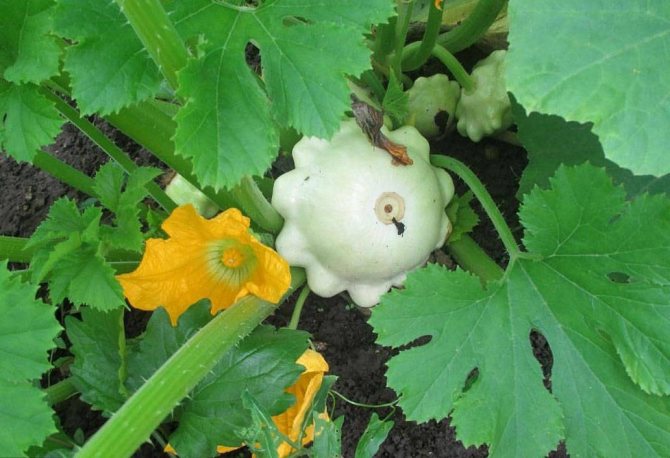

To get a high-quality tasty harvest, you need to seriously approach the issue of the timing of planting a vegetable.
The wrong sowing time can affect the fact that the vegetable does not have time to ripen before the onset of cold weather.
The climatic conditions of the country are very different in different regions, so the sowing time is different.
The table shows the approximate time that is suitable for a particular region of the country.
Table 1. Dates of sowing squash in open ground by regions of Russia:
| Sowing dates | Country region |
| May 15-20 (with cover), May 20-30, June 5-10 | Moscow region and middle lane |
| May 10-June 15 | Central |
| April 20 - May 10 | Yuzhny |
| From June 15 | Far East |
| Greenhouse | Northwestern |
| Greenhouse | Siberia and the Urals |
Features of soil preparation
The recommended soil for the vegetable is black soil, light loam. The best choice is a neutral soil, so mistakes can be avoided.
If the soil is acidic, wood ash is added to it.
The preparation of the soil for the squash is carried out in the fall or spring. At the same time, an important place is occupied by the question of applying fertilizers, which affect the quality and quantity of the crop.
Autumn preparation
To properly prepare a bed for a crop, you need to follow the instructions:
- First, remove the previous culture.
- They dig up the soil with a rake, remove the rhizomes of plants, weeds.
- Fertilizers are also applied since autumn. Humus or compost is used for digging. At the same time, light soils require less organic fertilizers, heavy soils more.
Spring preparation
In early spring, after the snow melts, when the soil warms up, they begin to prepare it.
To do this, loosen it 2 times, harrow. The first time, loosening is carried out to a depth of 5 cm.
Just before sowing, you need to loosen the soil again. Here, the depth is already shallower - 10 cm. At this stage, all weeds are also removed.
Fertilizing the soil and preparing seeds before planting
Before planting the squash, 5 kg of humus, 40 g of superphosphate, 25 g of potassium salt are added per 1 square meter.
All fertilizers are distributed in such a way that they are evenly distributed throughout the entire area.
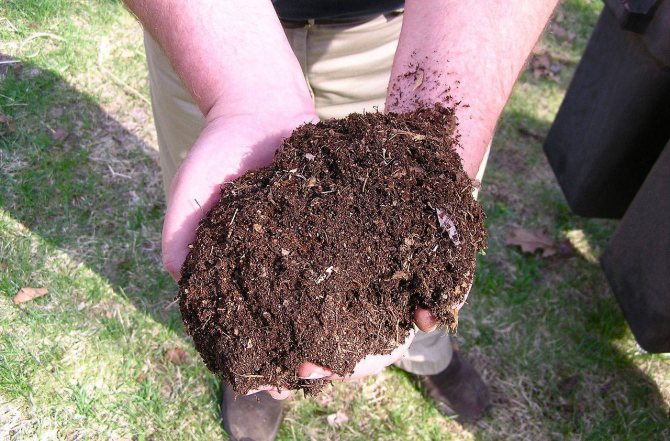

Regardless of the method of growing the vegetable, the planting material must be prepared for sowing:
disinfect, warm up, harden, treat with growth stimulants.
The first stage is warming up. To do this, you need to place the planting material in an oven heated to 50 ° C.
The seeds are heated for 5 hours. You can also warm them up on the battery for 7 days. The heated seeds need to be cooled.
Next, they proceed to etching. You can disinfect the planting material in a 1% solution of potassium permanganate.
For dressing, simply dip the seeds in a hot pink solution and hold for 20-30 minutes. Then rinse with clean water, dry.


You can harden the planting material in the refrigerator. It is enough to put it on the lower shelf for 6 hours.
The last stage will be treatment with growth stimulants. They are purchased in the store, these are the preparations Epin, Buton, Energen.
You can also use folk remedies. Experienced gardeners use aloe juice diluted with water to accelerate seed germination.
After all the procedures, the seeds are washed with clean water and placed on wet gauze for 2 days.
During this time, you need to ensure that they are constantly wet.
The air temperature in the room at this stage should be + 23 ° С.
Squash in the garden: combination with other plants
To increase the yield and prevent the occurrence of many diseases, it is important to choose the right neighborhood for the crop.
It is best if they grow along with radishes, onions, garlic, corn.
It is also good to grow squash together with cucumber, thyme or nasturtium. Marigolds planted next to the vegetable will help scare off aphids.
Facilitates care, planting a combination of squash with pumpkin, beans or cabbage. In this case, you can harvest one crop and plant another.
Planting greenery is also successful. For example, dill or salad.
Potatoes will be a bad neighbor for squash. However, if you plant a vegetable in the place where the potato tubers used to be, it will delight the gardener with a good harvest.
It is also not recommended to grow side-by-side squash and zucchini. They are related plants.
In order to prevent cross-pollination, you cannot plant a vegetable next to cucumbers. Beets are unfavorable neighbors for squash.
Seedling preparation rules
A gardener who wants to grow squash for the first time should know that these vegetables grow faster if they were planted in open ground from seedlings.
Growing plants in greenhouse conditions or under a special film that covers young seedlings allows you to get bountiful harvests.
If there are not enough containers for pre-growing seedlings, you can germinate seeds in plastic bags or in flowerpots.


Seeds are sown when the weather is already warm outside. This period usually begins by early May. For this, glasses with a diameter of ten centimeters are suitable.
For soil, you can use soil purchased from a specialist gardening store. Forest soil mixed with sand as well as humus will also be appropriate.
And in what way do you grow squash?
Seedling
Planting seedlings:
- Seeds, prepared in advance, are placed in cups at a distance of 4 centimeters, then poured over them with water. The glass is covered with foil until the first shoots and removed to a warm balcony or windowsill.
- After pecking the first shoots, the glasses are removed from a warm place and placed in a room where the temperature is no more than 18 degrees.
- After one week, the seedlings are put back in their former warm place. Watering is carried out rarely and in moderation.
- After the seeds germinate, you need to fertilize. To do this, a mullein is bred with clean water in a ratio of 1:10. The same feeding method is used before planting in open ground.


Planting is recommended three, and sometimes four weeks after sowing. By this time, three true leaves will already appear on the seedlings.- Planting is carried out in the early hours before sunrise in order to reduce the shock situation for young plants. Planting is carried out together with a lump of earth from a cup.
- After planting, you need to water the seedlings with clean water.
- Patissons are large vegetables, so planting is carried out at a distance of 76-80 centimeters. If planting is carried out in spring, then it is recommended to cover young plants with a film. This will allow you to transfer possible frost.
- If the weather continues without rain, then the first flowers will appear in two weeks. In this case, the protection from the cold is no longer needed; it can be eliminated.
How to water squash?
Patissons need to be watered abundantly. However, if the soil is too full of liquid, the plant can deteriorate. This will be seen by the state of the leaves and fruits, where the decay process will begin.
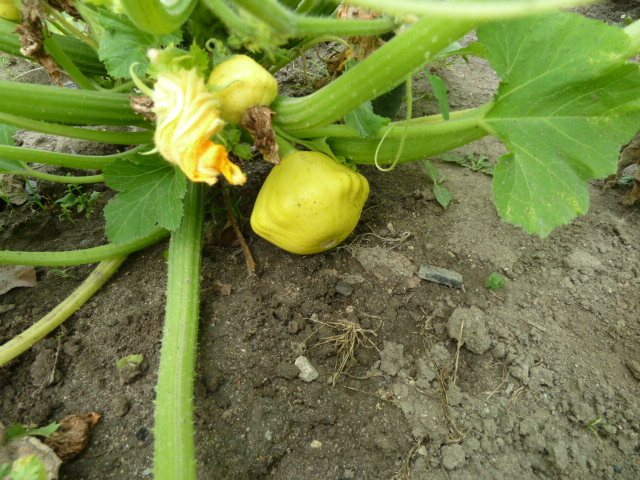

Watering recommendations:
- the water temperature for irrigation should be within 23-25 degrees;
- watering is carried out once every five days;
- after the beginning of flowering, watering is increased up to 1 time in three days.
- the stream of water should be directed under the root of the plant, if it hits the inflorescences, the process of decay will begin, so such actions should be avoided.
Harvesting
For food, squash is harvested at the stage of technical maturity - until their peel is tender, thin, "waxy", while the grains inside have not yet matured. Usually, the ripening time is indicated on the seed bag and depends on the variety. If the skin has already hardened and hardened, it is better to leave such squash for seeds and remove when the bush begins to dry out.


How to grow squash
Like other pumpkin crops, this vegetable is grown by sowing seeds. At the same time, in the middle lane and further to the north and east, the seedling method is recommended. This will not only allow you to get the harvest earlier one and a half to two weeks, but also protect the plants from possible return cold. You can grow seedlings in a greenhouse, in greenhouses, and then transplant them into ridges.
Seeds of various varieties of squash are on sale, so everyone can purchase suitable seed material.
Seed preparation
Regardless of whether squash will be grown by seedlings or through sowing directly into the ground, the seeds must be prepared. To do this, it is recommended to warm them up (about 5-6 hours at a temperature of + 50ºC), and also soak them in a growth stimulator. Suitable formulations such as "Bud" (preparation for cucumbers, zucchini and squash), as well as "Energen". The solution is prepared strictly according to the instructions.


You can also warm them up at a lower temperature (for example, on a heating battery), only then the heating period must be increased to several days.
ON A NOTE!
For disinfection, a pink solution of ordinary potassium permanganate is used, in which the seeds are kept for 20-30 minutes. Then they must be rinsed with clean water.
Instead of potassium permanganate, boric acid can be used (take 20 mg of the drug per liter of pure water), the seeds are kept in a solution for 20-24 hours.
It is also advisable to germinate the seeds by placing them in a damp cloth.
Sowing seedlings
Containers and nutritious soil are prepared for seedlings. Since the squash cannot stand picking, the seedlings must be grown immediately in separate pots. The soil can be purchased at the store, and if all the necessary components are available at home, then prepare it yourself. As an option: take river sand, humus and sod land in a ratio of 1: 2: 1.


Sowing dates depend on the climate of the region, so each gardener takes into account the peculiarities of the area. It is necessary that by the time the seedlings can be planted in the garden, the plants are three or four weeks old, and they also have 2-3 true leaves. For greenhouse plants, all indicators remain the same.
For the middle lane, sowing for seedlings at the end of April will be optimal, so that already in the last days of May or the beginning of summer it would be possible to easily determine the patissons on the ridges.
Usually, many gardeners sow two seeds in each glass or pot. After that, a more developed and strong one is left, and the other is neatly cut off. You can sow one seed at a time, if the planting material is of high quality, everyone will sprout.
The containers are covered with foil or glass and placed in a warm place (temperature - up to +28 ºC). As soon as sprouts appear, the film must be removed, and the pots themselves must be exposed to light and the temperature regime must be slightly reduced (up to +22 ºC).
ON A NOTE!
This rule should not be neglected. With a slight decrease in temperature, the plants will actively grow roots, and the seedlings themselves will not stretch out.
Further care for the squash is simple: watering, feeding. For young seedlings of squash, one or two dressings will be quite enough, for which mullein infusion or nitrophosphate is used. Seedlings grow quickly, delighting with their green leaves.
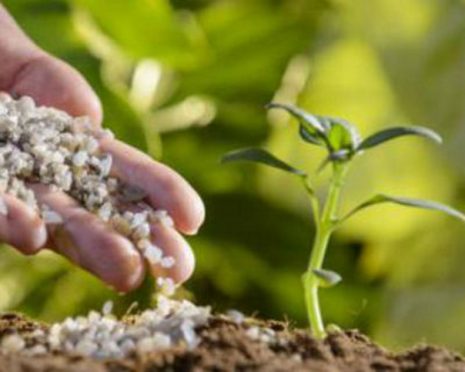

About a week before planting, it would be good to harden the plants, taking them out for several hours on an open balcony, loggia or veranda.
Site preparation for squash
Patissons are sown in an open, well-heated and ventilated bed. It is better to cultivate the soil in the fall. The site must be treated with organic fertilizer, and then plowed or dug up without breaking clods of earth. If the soil is acidic, it is necessary to calcify the site in the fall.
In the spring, the plot is leveled with a rake, weeds are destroyed, and in the second half of May they are brought in for digging, depending on the structure of the soil, below the following organic (if they have not been applied since autumn) and mineral fertilizers.
Varieties with colored fruits
You can decorate the site by growing squash with delicious fruits of different colors. Suitable vegetables of the following varieties: The fruits of the "sun" are colored orange, grow up to 300 g. On a compact bush grow up to 15 bright pumpkins with dense creamy pulp. Ripen on average up to 60 days. On a small bush of "malachite" there are disc-shaped fruits, the delicate flesh of which is white and of excellent taste. Unripe malachite green pumpkins brighten when ripe. Productivity from one bush - up to 20 kg. The plant has good immunity, caring for it does not require effort. Unpretentious in care variety "sunny bunny" gives fruits of bright yellow color with creamy pulp and a unique taste without bitterness. Fruiting is amicable and abundant, mainly female flowers are located on the plant. Under the dark purple skin of the bingo bingo fruit, there is a juicy white flesh. Pumpkins of an early ripening variety have low keeping quality and yield, but they grow up to 600 g.The seeds of the "color trio" consist of a mixture of squash of different varieties with fruits of various colors. Plants with medium early ripening periods were selected. This mixture is recommended by experienced vegetable growers, not only for decorating the site. The multi-colored fruits look beautiful together in pickled form.


Photo:
Yellow-orange patissons were bred from white-fruited varieties. They are distinguished by a high content of carotene, lutein and vitamin A, which makes them popular in dietary and medical nutrition.
Experts recommend including squash in the menu for patients with anemia and gastrointestinal diseases.
A huge assortment of varieties of squash makes it possible for vegetable growers to choose plants that are most suitable in terms of ripening, appearance and, of course, taste. Knowing the climatic conditions of your region, you can take care of growing vegetables that will be comfortable and easily adaptable. In addition to choosing a variety, do not forget about caring for these generally unpretentious plants.
Soil requirements
Patissons welcome crumbly loamy soil and black soil. Preference should be given to soil with a neutral reaction. If the soil is slightly acidic, you can balance it by adding wood ash. For this vegetable crop, soil fertilization is of great importance.
It is better to choose organic fertilizers as nutrients. Before sowing seeds into the dug soil, it is necessary to add semi-rotten manure, combined with mineral additives, into it.
How to prepare for planting squash
If the summer cottage cannot boast of a large area, and it is occupied by other vegetable crops, you can grow squash in containers. Pots, plastic bags or containers are suitable for the latter.
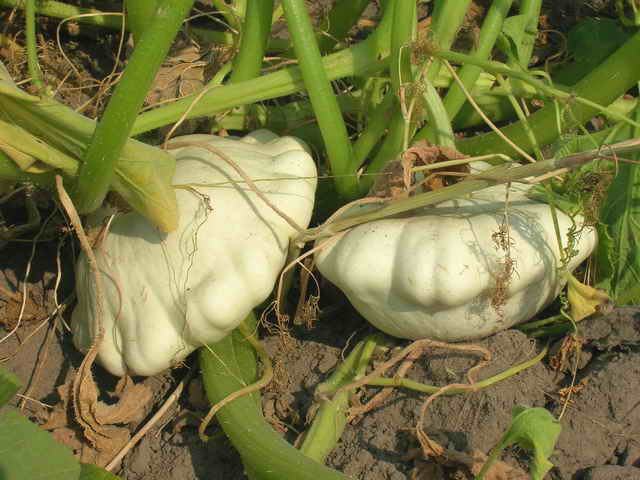

Patissons in the garden. Illustration for this article is used under a standard license.
Squash care
The principle of caring for squash planted in the ground does not constitute special skills. If the correct fertilizing of the soil and further planting of plants in the ground have been made. The basic rules for care are reduced to regular watering and removal of weeds that prevent plants from developing and sprouting into bushes. In order for the bushes to be not too massive, it is recommended to install supports and tie up too heavy fruits.


Old leaves should be removed. Therefore, the plant must be examined for old leaves, especially in the lower part of the squash.
It is important to carry out a detailed examination for fungi and damage to the fruit by insects. This is due to the fact that the fruits are located in close proximity to the ground.
Autumn preparation
Growing squash must be carried out taking into account certain rules. The plot for sowing is being prepared in the fall. After the previous crop and its plant debris are removed, the bed is loosened so that weeds can sprout. After 14 days, the place is dug to a depth of 25 cm, and all sprouted weeds are eliminated.
For digging the earth, manure (10 kg per square meter), humus or compost (5 kg per square meter) is applied. To fertilize heavy soils, it is recommended to take more organic fertilizers.
Small-fruited varieties for canning
In canning, pumpkins of any varieties harvested unripe are used. Having plucked fruits up to 7 cm for pickling, the vegetable grower stimulates the appearance of new pumpkins.
It is useful and beautiful to use fruits of small-fruited varieties for pickling. Small squash looks more impressive among pickled vegetables.
Vegetable growers recommend using mini squash seeds for planting:
- "umbrella";
- "disk";
- "Cheburashka";
- "Marrov" - a high-yielding mid-season variety;
- "Patch";
- “Marinka” is an early ripening variety;
- "Cheburashka".
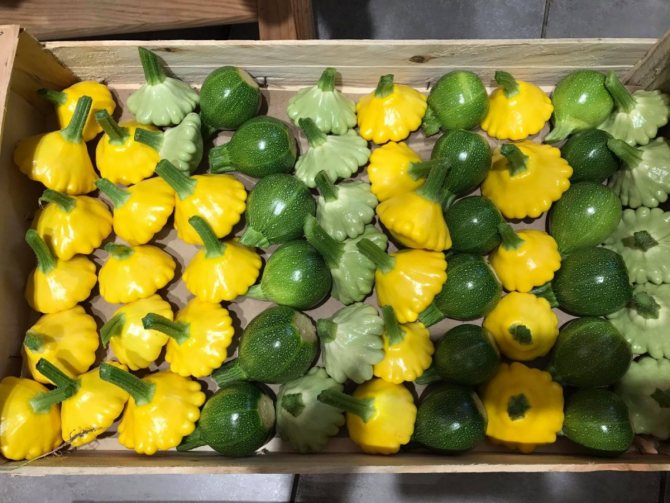

Photo:
Let's consider some small-fruited varieties: Fruits of the “mini-crumb” variety are used for canning as a whole, their diameter is up to 5 cm, weight is up to 70 g.They taste no worse than large-fruited squash. The crop ripens after 50 days; in a few weeks of fruiting, up to 5 kg are harvested from one bush. Growing does not require any special technology. The bushes themselves with small fruits and leaves look decorative. Mini-squash "solar explosion" recently appeared on the sites of Russian vegetable growers. Not much different from the "mini-crumb" variety. "Chartreuse" differs not only in small fruits, but also in early ripening, a little more than a month. On dark green glossy fruits, stripes of white or yellow appear over time. Both delicious and beautiful! The fruits of the early ripe hybrid "sunny bunny" grow up to 200 g, have a dense, light orange, tasty pulp. Up to 20 squash can ripen on one bush, the harvest can reach 15 kg per season. The plant does not suffer from powdery mildew or other diseases.


Photo: <>
What do squash look like and how are they useful?
Squash is an annual bushy plant or shrub belonging to the Pumpkin family. Its closest "relatives", pumpkin and zucchini have long been well known to gardeners. Most botanists consider South America to be the birthplace of the squash, although there is evidence that this plant was cultivated in ancient Egypt. Wild squash in nature has not yet been found, so the question remains open.
Europe got to know them during the era of great geographical discoveries. The plant was brought home by Spanish sailors. The Mediterranean climate suited the culture very well, and it quickly gained popularity. Now squash is almost an integral part of French cuisine. Even the common name comes from the French pâté (pie), which describes the unusual shape of the fruit. And squash is often called "dish pumpkins".
An exotic vegetable came to Russia in the 17th century. It cannot be said that the culture fell in love immediately and forever, nevertheless, two hundred years later, squash could be found even in Siberia. They have adapted well to the harsh climate. Although their frost resistance is such that most varieties will not tolerate even a short-term drop in temperature to negative values.
The plant is quite compact, the whips are short. The leaves are large, harsh to the touch, covered with sparse "villi". The flowers are solitary, golden yellow, bell-shaped in shape. They are unisexual, so in order for the fruit to set, the plant needs the "help" of insects or a gardener.
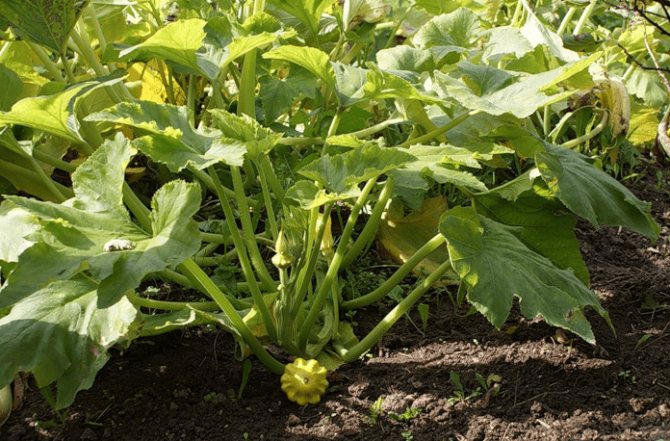

Squash bushes, as a rule, are quite compact
The fruit of the squash is pumpkin. Weight varies from 250-300 g to 800-1000 g, diameter - from 7-10 cm to 25-30 cm. You should not hesitate with harvesting. The larger the squash becomes, the more its skin coarsens. The pulp becomes cottony, almost tasteless. Such specimens can only be used for harvesting seeds if the variety being grown is not a hybrid.


The flowers of the squash are unisexual, pollination is impossible without assistance
Most often, the skin is colored white, salad or dark green. But breeders have bred yellow, orange, purple, variegated squash. The fruit resembles a plate or bowl in shape. The pulp is tender, with a light nutty flavor. Although some gourmets note that the taste of the squash reminds them of asparagus or artichokes.
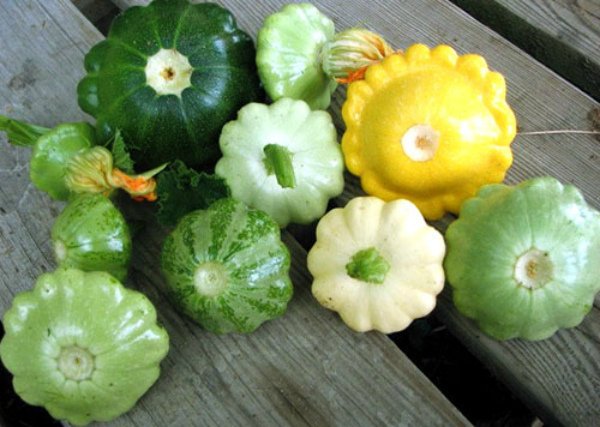

The selection varieties of the squash differ mainly in the color of the skin and the shape of the fruit.
Squash are widely used in cooking. They can replace zucchini in any recipe. The unusual shape of the fruit makes it ideal for stuffing. Both mature and young squash are eaten. The latter can generally be eaten raw. It is the fruits aged 7–10 days that have reached a diameter of 5–7 cm that are most highly valued by professional chefs. They are also stewed, fried, pickled, salted.
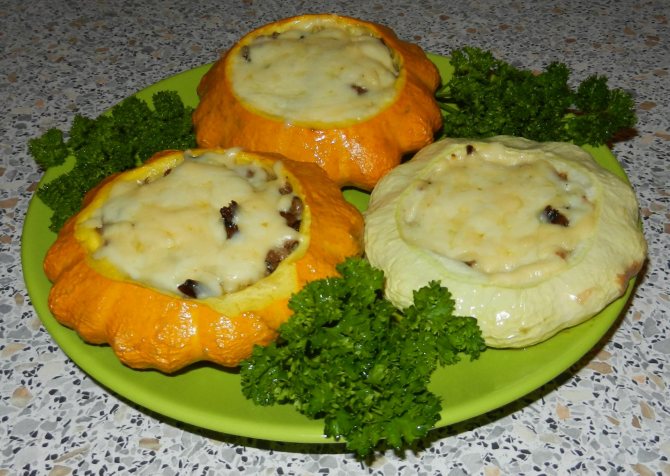

Patissons are stuffed with meat, vegetables, rice, the shape of the fruit is very convenient for this
Patissons are not only tasty, but also healthy. The pulp is rich in pectin, fiber, protein, unsaturated fatty acids, glucose and fructose. It is absorbed quickly and helps to digest heavier foods. Of the trace elements, the presence of potassium, phosphorus, magnesium, calcium, copper, iron, zinc, cobalt, sodium can be noted. In terms of the content of vitamins of group B, C, E, PP, squash surpasses pumpkins and zucchini. Yellow-skinned varieties are rich in carotenoids and lutein. This natural antioxidant helps to improve blood composition (especially in case of hemoglobin deficiency), lower cholesterol levels, and has a beneficial effect on vision.
The squash diet has long been known and proven to be effective. Its main product can be easily replaced with squash. They are also low in calories. Nutritionists recommend using the fruit to prevent diseases of the cardiovascular system, normalize bowel function, with kidney and liver problems. Squash are hypoallergenic, mashed potatoes are suitable even for small children. The only contraindication is individual intolerance.
Squash seeds can be compared to eggs in terms of lecithin content. It is a valuable source of protein for vegetarians. The powder from them helps to normalize the activity of the endocrine and nervous systems. The juice effectively removes excess salts and fluids from the body. Its regular use is an effective prevention of kidney disease. A good diuretic and mild laxative is pulp puree.
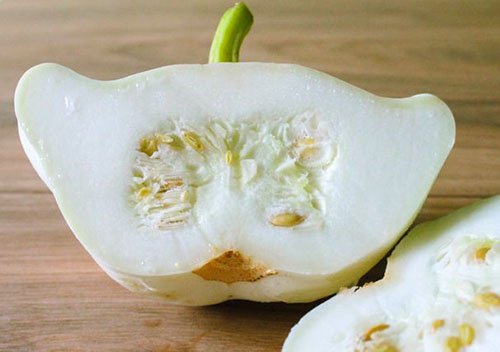

The pulp of the squash is very useful for health, and its seeds are also used in folk medicine.
It is quite simple to distinguish squash from squash. Just look at the fruits. If we talk about less noticeable differences, the squash bushes are more compact, the leaves are smaller. The pulp of the fruit is denser, it has its own pronounced, rich taste. But squash is much superior to squash in yield and early maturity.
Video: squash and their health benefits
Early varieties
Early varieties include green, white, yellow species. Among these vegetables:
- Chartreuse f1. This variety is small in size and belongs to the early maturing varieties. The f1 green emerald pumpkins are only a few centimeters in diameter. As a rule, their color is "diluted" with white or light yellow stripes. Due to their size, these mini squash can be preserved whole. The fruits of the f1 variety have a delicious white pulp. This f1 variety brings undoubted benefits in cooking and decorates the garden with striped fruits.
- "Sunny Bunny". This variety of squash has small fruit sizes. It has a golden color, like a bright yellow sun. Perfect for rolling, and in general. This variety is characterized by tasty pulp, and one fruit weighs no more than 200 g. The shrub, as a rule, is dotted with mini-vegetables, is not whimsical and capricious when grown and is resistant to various diseases and pests.
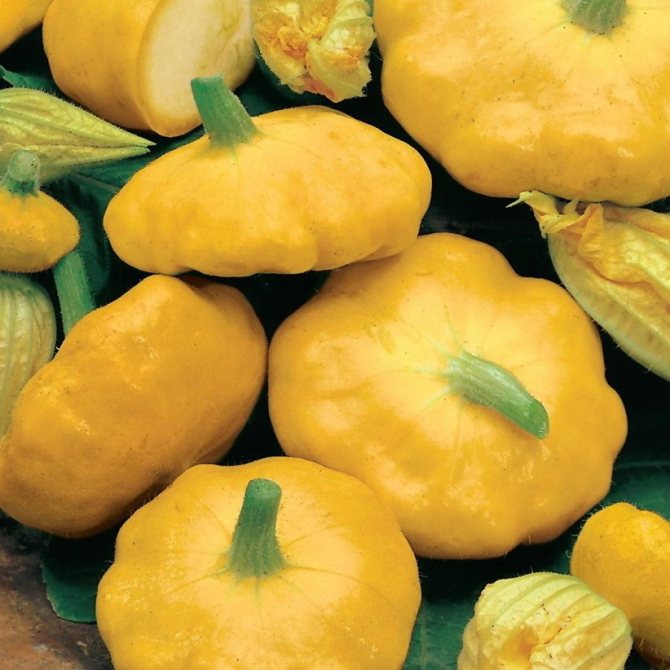

- "UFO Orange". Golden, early ripening pumpkins delight with their ripening literally 45 days after the seeds were planted. Beautiful, bright and undoubtedly tasty fruits are perfect for baking in pots or for preservation. The weight of one fruit is about 500 g, the shrub gives a high yield and endures the "attacks" of pests.
- Cheburashka. This variety perfectly tolerates cold, quickly forms an ovary and ripens within 35-40 days after the seeds have sprouted. This is one of the best early maturing early varieties. Its bushes are very powerful and strong, the weight of one fruit is about 400 g, and the pulp is tender and pleasant to the taste.
- "Disk". An early ripening white variety that resembles a bell. During ripening, it is painted in a greenish tint, and then becomes dazzling white. If you pick even small squash, they can be used in twists, in whole form or baked on the grill.An "adult" specimen reaches 350 g in weight and is well preserved for a long time.
The best unique early species that you can surprise with are "Gosha" and "Bingo-Bongo". They will delight true lovers of exotic and connoisseurs of everything unusual. A description of these types is presented below:
- "Gosha" belongs to the early varieties, its seeds turn into malachite vegetables. At the end of ripening, it turns into black fruits weighing about 300 g. The crop gives excellent yields throughout the season.
- "Bingo-Bongo" is an early type with an original green-purple coloration. Huge fruits, weighing 600 g, resemble a tureen with wavy edges.
Is the patisson a species or a variety?
The Internet contains a lot of information about the squash plant, but what is true and what is not is difficult to determine. This is a type of common pumpkin. It was from her that the plants inherited the ability to change the color, shape and hardness of the vegetable when fully ripe. The fruit of a bizarre plant that has been lying for too long is extremely difficult to eat, because it is woody.
Since the squash itself is already a variety, it is impossible to talk about the types of vegetables. But you can classify these plants according to their characteristic features. Breeders have provided an opportunity to group varieties in a way that is convenient for a person:
- by the shape of the fruit,
- by the color of the fruit,
- by the ripening period,
- by weight of the fetus,
- in the shape of a bush.
From the point of view of practical application, it is convenient to group varieties by ripening time and weight.
Do not forget that the fruit of the squash plant can be called "squash" and "pumpkin", both names are correct.
Patisson - dish pumpkin - video
Squash: growing (video)
It is better to grow it in areas warmed by the sun and protected from the wind. Perhaps growing it together with potatoes and corn. Plants thrive on compost heaps. Adequate warmth and nutrition are beneficial for growth and development. You should not grow squash in the same garden for more than two years in a row.
The culture is thermophilic. If conditions are favorable, seedlings appear 6 to 9 days after sowing.
Shading of plants should be avoided. This negatively affects the amount of the crop. The plant should be provided with adequate ventilation. Drought tolerant culture. But, nevertheless, it is necessary to maintain sufficient soil moisture, especially during the period of flowering and fruit formation. The water should not be cold. When watering, avoid getting moisture on flowers and ovaries. Otherwise, rot may form.
The first feeding is carried out when the plant has formed 3 - 4 full leaves. The second during the flowering period.
If the plant is grown in a greenhouse, then manual pollination is required.
Pests and diseases are characteristic of all pumpkin crops. These are spider mites, melon aphids, root rot, white rot, anthracnose and powdery mildew.
The crop is harvested two to three times a week. Trying not to overripe the fruit. Their optimal size is 7-12 cm. The crop is not subject to long-term storage. The plant is capable of bearing fruit until the first cold weather.
It is better to grow it in areas warmed by the sun and protected from the wind. Perhaps growing it together with potatoes and corn. Plants thrive on compost heaps. Adequate warmth and nutrition are beneficial for growth and development. You should not grow squash in the same garden for more than two years in a row.
The culture is thermophilic. If conditions are favorable, seedlings appear 6 to 9 days after sowing.
Shading of plants should be avoided. This negatively affects the amount of the crop. The plant should be provided with adequate ventilation. Drought tolerant culture. But, nevertheless, it is necessary to maintain sufficient soil moisture, especially during the period of flowering and fruit formation. The water should not be cold.When watering, avoid getting moisture on flowers and ovaries. Otherwise, rot may form.
The first feeding is carried out when the plant has formed 3 - 4 full leaves. The second during the flowering period.
If the plant is grown in a greenhouse, then manual pollination is required.
Pests and diseases are characteristic of all pumpkin crops. These are spider mites, melon aphids, root rot, white rot, anthracnose and powdery mildew.
The crop is harvested two to three times a week. Trying not to overripe the fruit. Their optimal size is 7-12 cm. The crop is not subject to long-term storage. The plant is capable of bearing fruit until the first cold weather.
How to plant squash seeds
Before planting the squash, you need to make sure that the land prepared in the fall for sowing will be well warmed up by the end of spring and the period of night frosts has passed. The soil on the site must be leveled with a rake, weeds must be removed and the number of beds must be made. The size of the grooves will be 7 x 7 cm. So the plantings will not turn out too thick and the squash will not rot.
Several pieces of seeds go deep into the ground by 8 cm, after which the hole is covered with soil. After that, the beds need to be compacted, watered and covered with foil until the first shoots appear.
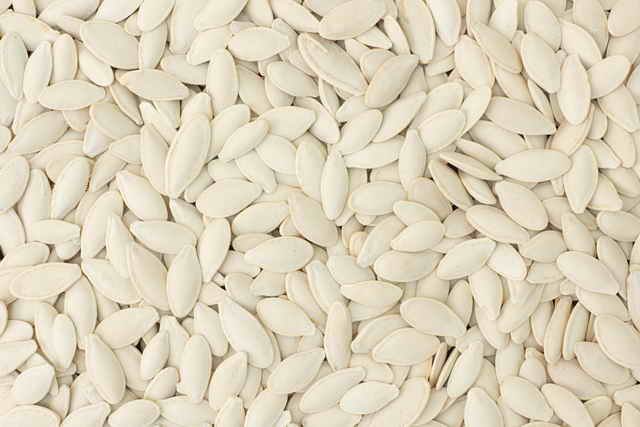

Growing from seeds. Illustration for this article is used under a standard license.
Harvest
The most pleasant and exciting moment for any gardener is the beginning of fruit ripening and harvesting. Patissons are distinguished by a long ripening period, therefore, it is necessary to remove the fruits from the bush in time, preventing them from overripening.
Each variety has its own characteristics and this must be taken into account. But in general, it is recommended to collect the squash while they are young. Squash up to 6 cm are excellent for preservation as a whole, larger fruits - 8-10 cm are ideal for pickles, as well as stuffing. Larger fruits are used for side dishes, braising, roasting, caviar or stews.
The most delicious are young squash, which have a delicate skin and flesh. But in older fruits, the skin hardens, and the taste deteriorates.
We must also remember that due to untimely collection of fruits, the flowering of the plant may deteriorate, other ovaries may crumble, which will generally affect the yield. Collected squash can be stored for up to 8-10 days by placing them in boxes or on a shelf so that the fruits do not touch. This vegetable is not intended for long-term storage.
Is it difficult to grow a squash? As you can see, there are no special forces and difficulties, the main thing is to try to correctly follow all the recommendations and, of course, not to be lazy.
Spring preparation
With the arrival of spring, loosening of light soil is carried out earlier. The first loosening can be carried out to a depth of 15 cm, the second - 10 cm before sowing the seeds. At this stage, the destruction of sprouted weeds is also carried out. For digging up the earth, organic and mineral fertilizers are applied: up to 6 kg of humus or compost, 40 g of superphosphate and 25 g of potassium nitrate.
Fertilizers are spread evenly over the entire plot and compacted to the bottom during digging. In the lowlands, drainage, ridges and ridges need to be created.
The width of the beds will be 1 m, the height - 30 cm. The ridges are organized from the steep northern and gentle southern sides. It is important that their height is no more than 35 cm.The distance between them will be 80 cm.
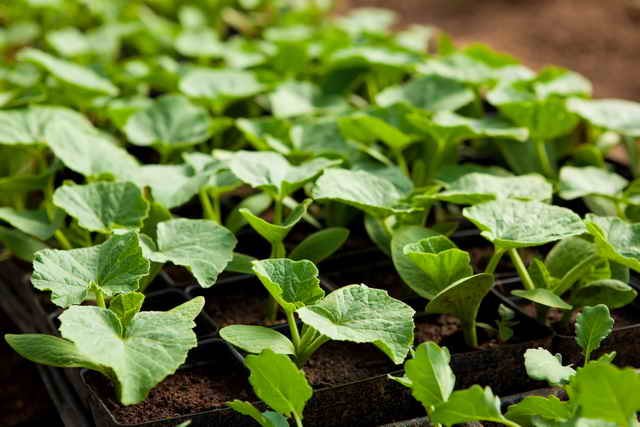

Saplings are preparing for the move. Illustration for this article is used under a standard license.
Growing squash: photo
Plant propagation and growing seedlings
For propagation of this pumpkin vegetable, seeds are taken. They are taken out of ripe fruits and dried in a warm room. Most often, the collection of seeds occurs closer to autumn. Therefore, you need to provide them with good conditions and care: diffused sunlight and ventilation.
If you want to start growing seedlings from seeds, then in the middle of spring you need:
- pour nutrient soil into peat pots or plastic cups;
- add mineral dressing;
- put 2 seeds in each container (depth - up to 4 cm);
- withstand the temperature regime: + 25 ° C - during the day, + 18 ° C - at night. After sprouting, you need to lower the temperature by a few degrees, and after a week, increase it again.
Sprout care is simple: sparse watering and airing. In open ground, seedlings are planted around the beginning of summer.



